CERTIFICATE: A Project Report for the Partial Fulfillment of the Award of Degree of Master of Business Administration (M.B.A.) Under the Guiance of Prof. Soma Dey
VerifiedAdded on 2023/04/22
|34
|8415
|325
AI Summary
Contribute Materials
Your contribution can guide someone’s learning journey. Share your
documents today.
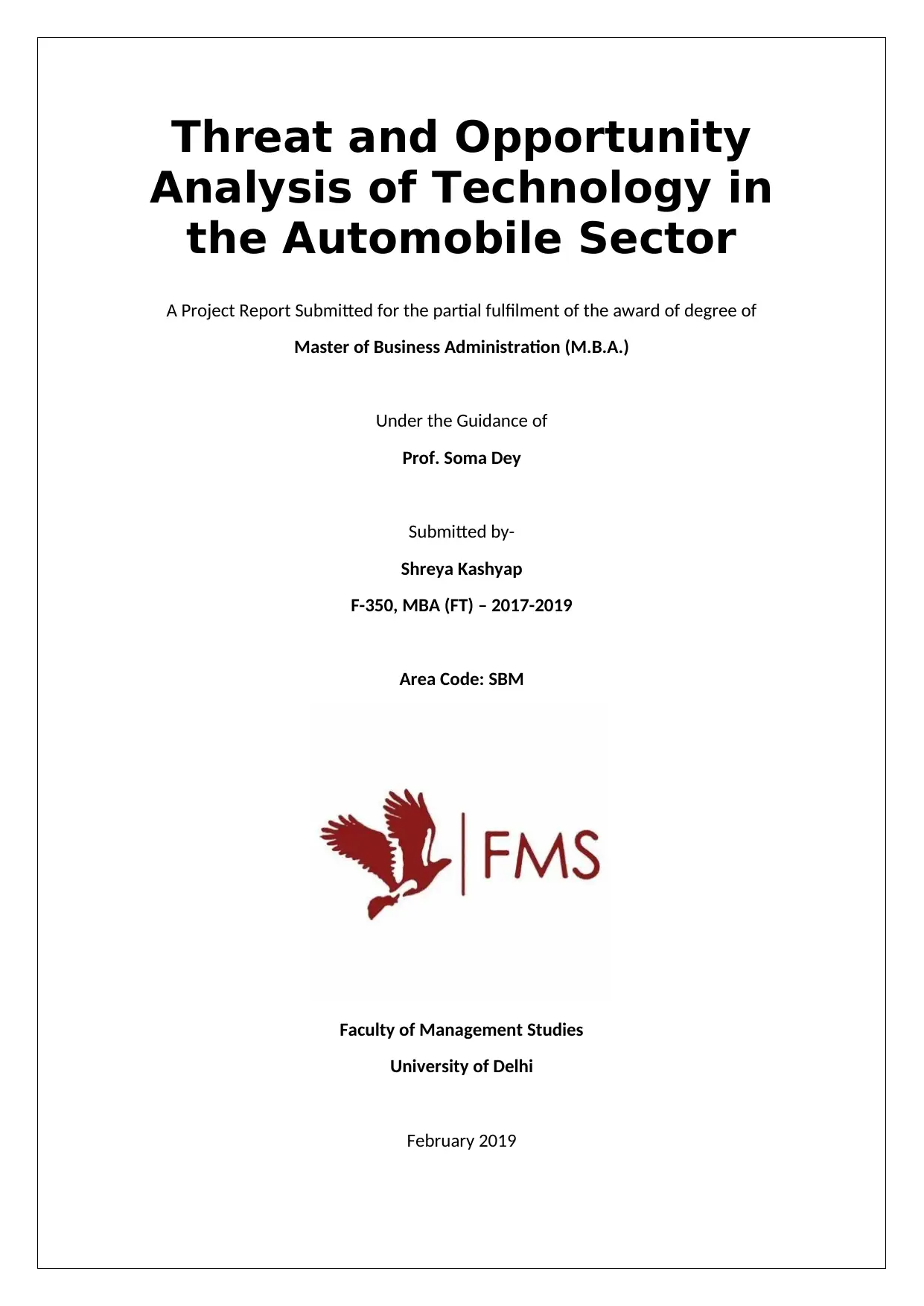
Threat and Opportunity
Analysis of Technology in
the Automobile Sector
A Project Report Submitted for the partial fulfilment of the award of degree of
Master of Business Administration (M.B.A.)
Under the Guidance of
Prof. Soma Dey
Submitted by-
Shreya Kashyap
F-350, MBA (FT) – 2017-2019
Area Code: SBM
Faculty of Management Studies
University of Delhi
February 2019
Analysis of Technology in
the Automobile Sector
A Project Report Submitted for the partial fulfilment of the award of degree of
Master of Business Administration (M.B.A.)
Under the Guidance of
Prof. Soma Dey
Submitted by-
Shreya Kashyap
F-350, MBA (FT) – 2017-2019
Area Code: SBM
Faculty of Management Studies
University of Delhi
February 2019
Secure Best Marks with AI Grader
Need help grading? Try our AI Grader for instant feedback on your assignments.
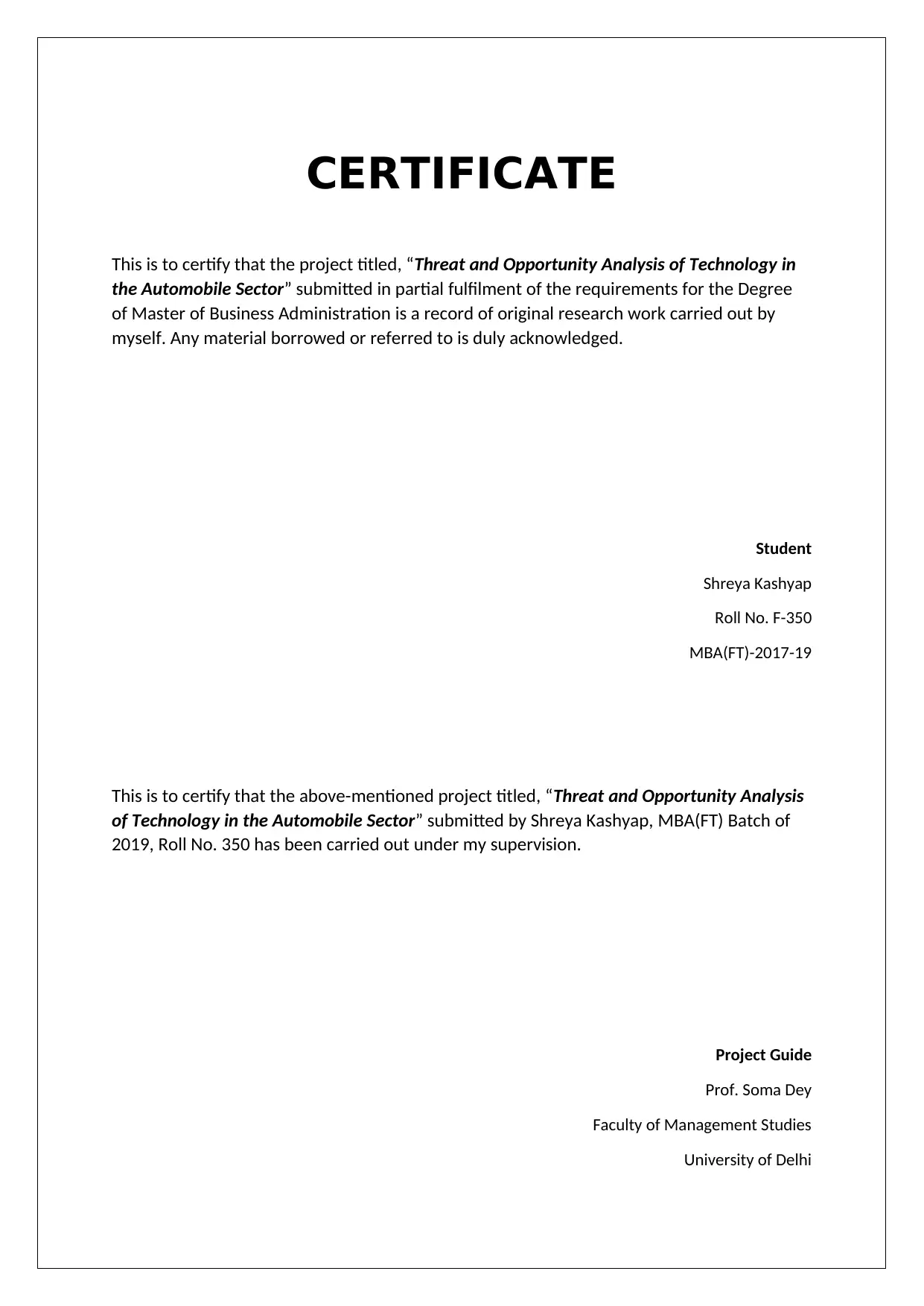
CERTIFICATE
This is to certify that the project titled, “Threat and Opportunity Analysis of Technology in
the Automobile Sector” submitted in partial fulfilment of the requirements for the Degree
of Master of Business Administration is a record of original research work carried out by
myself. Any material borrowed or referred to is duly acknowledged.
Student
Shreya Kashyap
Roll No. F-350
MBA(FT)-2017-19
This is to certify that the above-mentioned project titled, “Threat and Opportunity Analysis
of Technology in the Automobile Sector” submitted by Shreya Kashyap, MBA(FT) Batch of
2019, Roll No. 350 has been carried out under my supervision.
Project Guide
Prof. Soma Dey
Faculty of Management Studies
University of Delhi
This is to certify that the project titled, “Threat and Opportunity Analysis of Technology in
the Automobile Sector” submitted in partial fulfilment of the requirements for the Degree
of Master of Business Administration is a record of original research work carried out by
myself. Any material borrowed or referred to is duly acknowledged.
Student
Shreya Kashyap
Roll No. F-350
MBA(FT)-2017-19
This is to certify that the above-mentioned project titled, “Threat and Opportunity Analysis
of Technology in the Automobile Sector” submitted by Shreya Kashyap, MBA(FT) Batch of
2019, Roll No. 350 has been carried out under my supervision.
Project Guide
Prof. Soma Dey
Faculty of Management Studies
University of Delhi

ACKNOWLEDGEMENT
I would like to express my heartfelt gratitude to my guide Dr. Soma Dey for providing me the
opportunity to work under her guidance. Ma’am provided me with constant help and
support throughout the duration of this project. Pursuing a project in such a vast and
dynamic field would not have been possible without her encouragement.
Apart from the project work, I would also like to hereby thank Dr. Soma Dey for being a
faculty member who has always laid strong emphasis on creative thinking and always been
there for her students whenever they needed her support and guidance.
I would also like to thank the entire faculty at FMS, Delhi for providing me with an enriching
and I have learnt from several articles, research studies and papers from national and
international entities. I acknowledge the value I have received from these bodies of
knowledge.
Last but not the least, I would like to thank my colleagues and friends for their support and
words of motivation during the project tenure.
Shreya Kashyap
Faculty of Management Studies
University of Delhi
February 2018
I would like to express my heartfelt gratitude to my guide Dr. Soma Dey for providing me the
opportunity to work under her guidance. Ma’am provided me with constant help and
support throughout the duration of this project. Pursuing a project in such a vast and
dynamic field would not have been possible without her encouragement.
Apart from the project work, I would also like to hereby thank Dr. Soma Dey for being a
faculty member who has always laid strong emphasis on creative thinking and always been
there for her students whenever they needed her support and guidance.
I would also like to thank the entire faculty at FMS, Delhi for providing me with an enriching
and I have learnt from several articles, research studies and papers from national and
international entities. I acknowledge the value I have received from these bodies of
knowledge.
Last but not the least, I would like to thank my colleagues and friends for their support and
words of motivation during the project tenure.
Shreya Kashyap
Faculty of Management Studies
University of Delhi
February 2018

INDEX
Secure Best Marks with AI Grader
Need help grading? Try our AI Grader for instant feedback on your assignments.
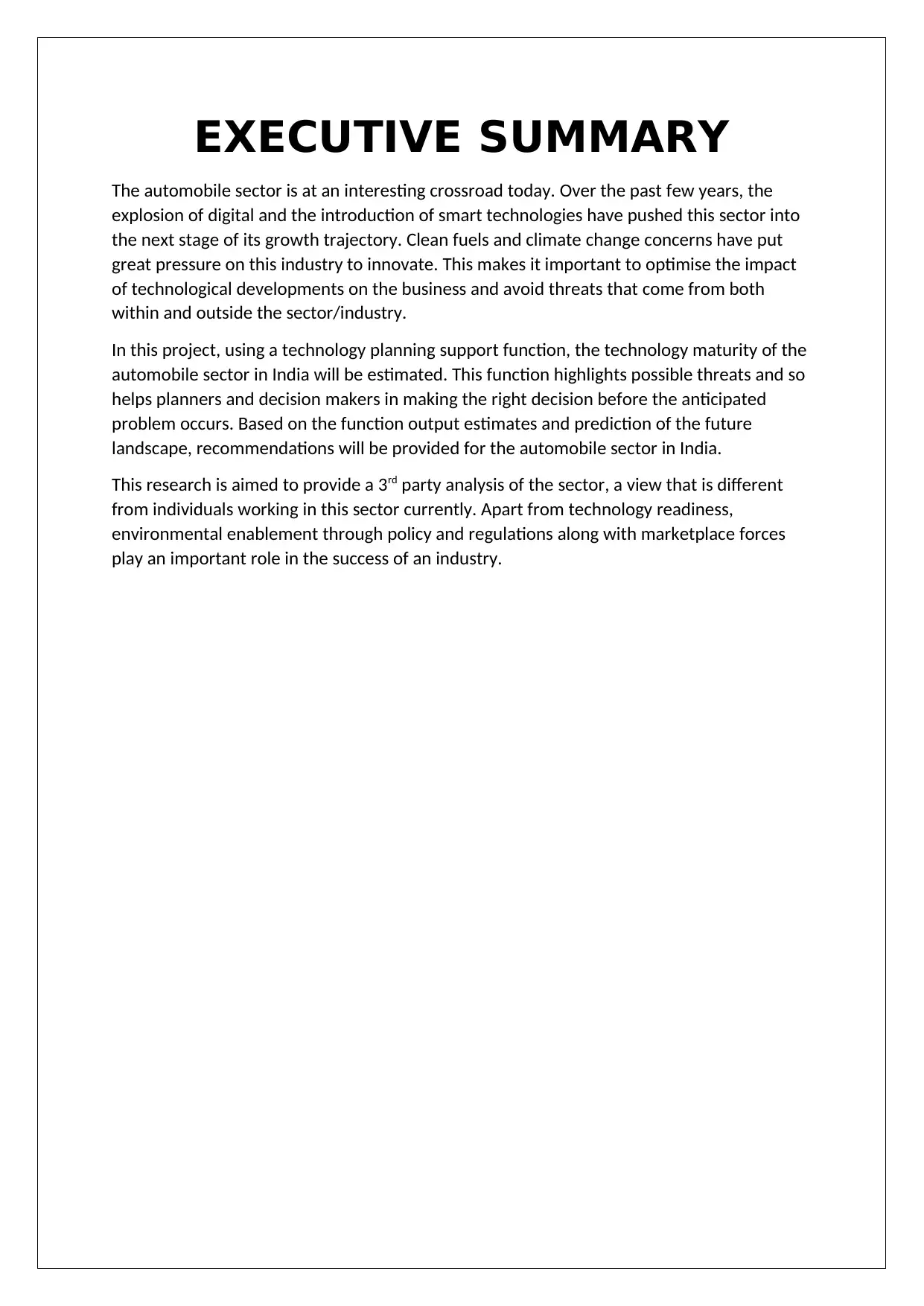
EXECUTIVE SUMMARY
The automobile sector is at an interesting crossroad today. Over the past few years, the
explosion of digital and the introduction of smart technologies have pushed this sector into
the next stage of its growth trajectory. Clean fuels and climate change concerns have put
great pressure on this industry to innovate. This makes it important to optimise the impact
of technological developments on the business and avoid threats that come from both
within and outside the sector/industry.
In this project, using a technology planning support function, the technology maturity of the
automobile sector in India will be estimated. This function highlights possible threats and so
helps planners and decision makers in making the right decision before the anticipated
problem occurs. Based on the function output estimates and prediction of the future
landscape, recommendations will be provided for the automobile sector in India.
This research is aimed to provide a 3rd party analysis of the sector, a view that is different
from individuals working in this sector currently. Apart from technology readiness,
environmental enablement through policy and regulations along with marketplace forces
play an important role in the success of an industry.
The automobile sector is at an interesting crossroad today. Over the past few years, the
explosion of digital and the introduction of smart technologies have pushed this sector into
the next stage of its growth trajectory. Clean fuels and climate change concerns have put
great pressure on this industry to innovate. This makes it important to optimise the impact
of technological developments on the business and avoid threats that come from both
within and outside the sector/industry.
In this project, using a technology planning support function, the technology maturity of the
automobile sector in India will be estimated. This function highlights possible threats and so
helps planners and decision makers in making the right decision before the anticipated
problem occurs. Based on the function output estimates and prediction of the future
landscape, recommendations will be provided for the automobile sector in India.
This research is aimed to provide a 3rd party analysis of the sector, a view that is different
from individuals working in this sector currently. Apart from technology readiness,
environmental enablement through policy and regulations along with marketplace forces
play an important role in the success of an industry.
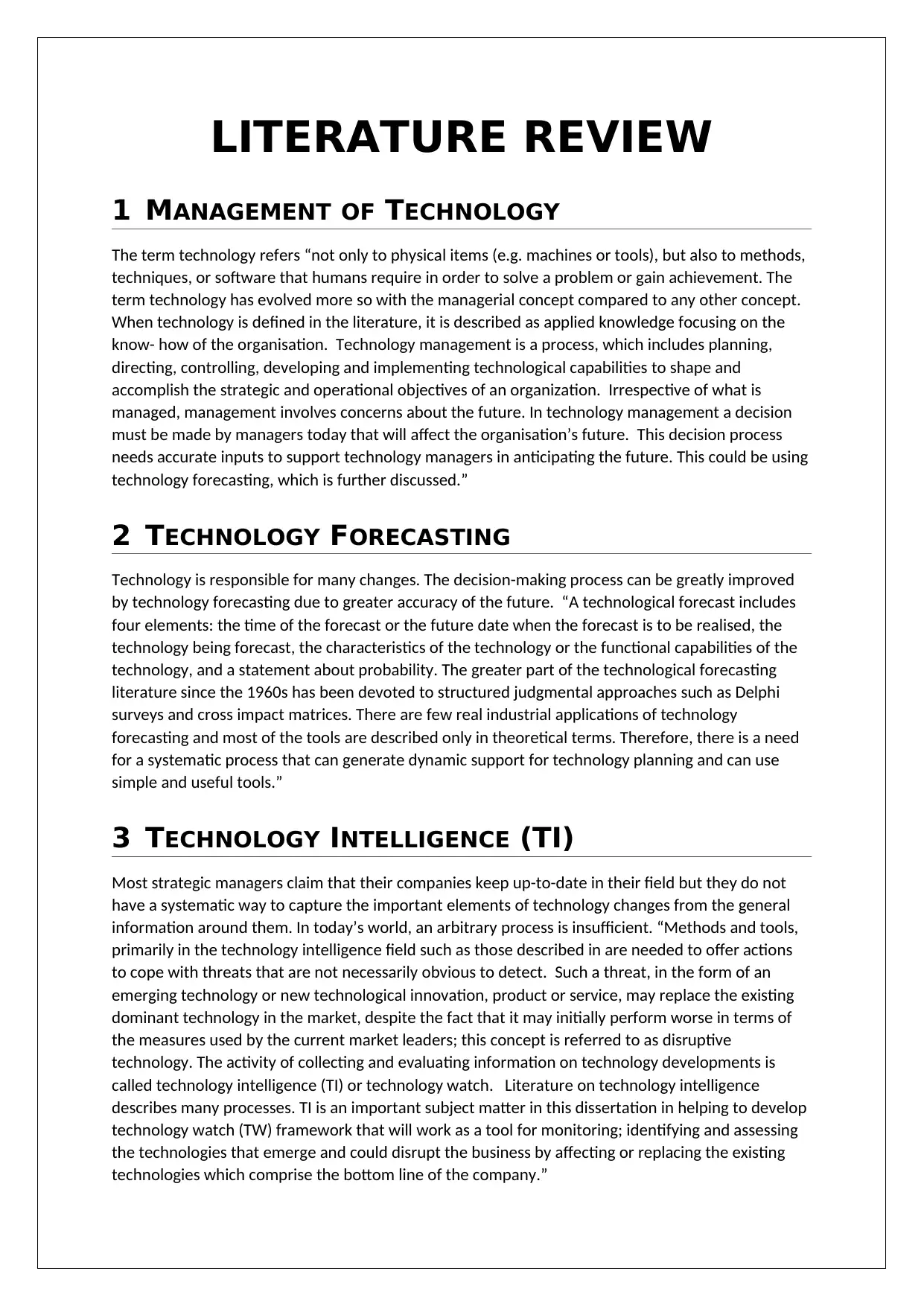
LITERATURE REVIEW
1 MANAGEMENT OF TECHNOLOGY
The term technology refers “not only to physical items (e.g. machines or tools), but also to methods,
techniques, or software that humans require in order to solve a problem or gain achievement. The
term technology has evolved more so with the managerial concept compared to any other concept.
When technology is defined in the literature, it is described as applied knowledge focusing on the
know- how of the organisation. Technology management is a process, which includes planning,
directing, controlling, developing and implementing technological capabilities to shape and
accomplish the strategic and operational objectives of an organization. Irrespective of what is
managed, management involves concerns about the future. In technology management a decision
must be made by managers today that will affect the organisation’s future. This decision process
needs accurate inputs to support technology managers in anticipating the future. This could be using
technology forecasting, which is further discussed.”
2 TECHNOLOGY FORECASTING
Technology is responsible for many changes. The decision-making process can be greatly improved
by technology forecasting due to greater accuracy of the future. “A technological forecast includes
four elements: the time of the forecast or the future date when the forecast is to be realised, the
technology being forecast, the characteristics of the technology or the functional capabilities of the
technology, and a statement about probability. The greater part of the technological forecasting
literature since the 1960s has been devoted to structured judgmental approaches such as Delphi
surveys and cross impact matrices. There are few real industrial applications of technology
forecasting and most of the tools are described only in theoretical terms. Therefore, there is a need
for a systematic process that can generate dynamic support for technology planning and can use
simple and useful tools.”
3 TECHNOLOGY INTELLIGENCE (TI)
Most strategic managers claim that their companies keep up-to-date in their field but they do not
have a systematic way to capture the important elements of technology changes from the general
information around them. In today’s world, an arbitrary process is insufficient. “Methods and tools,
primarily in the technology intelligence field such as those described in are needed to offer actions
to cope with threats that are not necessarily obvious to detect. Such a threat, in the form of an
emerging technology or new technological innovation, product or service, may replace the existing
dominant technology in the market, despite the fact that it may initially perform worse in terms of
the measures used by the current market leaders; this concept is referred to as disruptive
technology. The activity of collecting and evaluating information on technology developments is
called technology intelligence (TI) or technology watch. Literature on technology intelligence
describes many processes. TI is an important subject matter in this dissertation in helping to develop
technology watch (TW) framework that will work as a tool for monitoring; identifying and assessing
the technologies that emerge and could disrupt the business by affecting or replacing the existing
technologies which comprise the bottom line of the company.”
1 MANAGEMENT OF TECHNOLOGY
The term technology refers “not only to physical items (e.g. machines or tools), but also to methods,
techniques, or software that humans require in order to solve a problem or gain achievement. The
term technology has evolved more so with the managerial concept compared to any other concept.
When technology is defined in the literature, it is described as applied knowledge focusing on the
know- how of the organisation. Technology management is a process, which includes planning,
directing, controlling, developing and implementing technological capabilities to shape and
accomplish the strategic and operational objectives of an organization. Irrespective of what is
managed, management involves concerns about the future. In technology management a decision
must be made by managers today that will affect the organisation’s future. This decision process
needs accurate inputs to support technology managers in anticipating the future. This could be using
technology forecasting, which is further discussed.”
2 TECHNOLOGY FORECASTING
Technology is responsible for many changes. The decision-making process can be greatly improved
by technology forecasting due to greater accuracy of the future. “A technological forecast includes
four elements: the time of the forecast or the future date when the forecast is to be realised, the
technology being forecast, the characteristics of the technology or the functional capabilities of the
technology, and a statement about probability. The greater part of the technological forecasting
literature since the 1960s has been devoted to structured judgmental approaches such as Delphi
surveys and cross impact matrices. There are few real industrial applications of technology
forecasting and most of the tools are described only in theoretical terms. Therefore, there is a need
for a systematic process that can generate dynamic support for technology planning and can use
simple and useful tools.”
3 TECHNOLOGY INTELLIGENCE (TI)
Most strategic managers claim that their companies keep up-to-date in their field but they do not
have a systematic way to capture the important elements of technology changes from the general
information around them. In today’s world, an arbitrary process is insufficient. “Methods and tools,
primarily in the technology intelligence field such as those described in are needed to offer actions
to cope with threats that are not necessarily obvious to detect. Such a threat, in the form of an
emerging technology or new technological innovation, product or service, may replace the existing
dominant technology in the market, despite the fact that it may initially perform worse in terms of
the measures used by the current market leaders; this concept is referred to as disruptive
technology. The activity of collecting and evaluating information on technology developments is
called technology intelligence (TI) or technology watch. Literature on technology intelligence
describes many processes. TI is an important subject matter in this dissertation in helping to develop
technology watch (TW) framework that will work as a tool for monitoring; identifying and assessing
the technologies that emerge and could disrupt the business by affecting or replacing the existing
technologies which comprise the bottom line of the company.”

CHAPTER 1: INTRODUCTION
Globalisation of competition and the accelerating rate of technology change have created
difficult challenges for advanced technology-based industries in this new millennium.
Companies in these industries must now continually reduce costs and develop better
products and services in order to maintain a competitive advantage in an environment that
is constantly changing.
High costs for research and development (R&D) force high technology companies to choose
which technologies to invest in more carefully. Technologies are introduced into a company
in order to make a positive contribution to its products and services. Companies need
technology planning in order to make better decisions with regard to strategic corporate
planning, R&D management, product development, production and marketing.
The automobile sector has long been at the forefront of embracing new-age technology.
The technology future of this industry is ACES (Automated-Connected-Electrified-Shared). As
the automotive sector keeps innovating and the competition intensifies alongside, the risks
associated with extensive R&D in one field can have a detrimental impact on market share
and bottom line. Unpredictability of results and secrecy involving competitor R&D
investments makes technology planning and forecasting extremely important for a company
in this sector.
As the developing countries’ gross incomes rise, more and more people in these countries
are willing to make investments in the auto industry; buy cars for personal travel, trucks for
transporting goods or tractors for field work or even put in money for further avenues of
income generation. Since level of transportation and the GDP of any country are inter-
linked, improved GDPs of developing countries like BRICS (Brazil, Russia, India, China and
South Africa) indicate greater scope for automobile sector growth and penetration within
these countries. New technologies bring in benefits of greater cost to scale, improved
efficiency, increased comfort to end consumers and at times, a competitive advantage to
companies.
India is expected to emerge as the world’s 3rd largest passenger market by 2021 and also a
leader in shared mobility by 2030. It is expected to be at the forefront of electric and
autonomous vehicles in the years to come. With the benefits of growing demand due to
rising incomes of the middle class and young population, improving regulatory processes in
FDI and FII and a fairly competitive marketplace, India becomes an interesting geography for
this study.
As Uber and Ola are changing marketplace dynamics in the shared mobility space, Indian
government is going ambitious with its Electric Vehicles Plan, it is important to understand
the opportunities and threats that come with such developments. Understanding India’s
maturity in accepting these factors as well their feasibility of implementation are important
considerations for this study. Indian automobile companies in three segments will be
analysed using this model – Premium, Middle Segment and the Economy Segment. Before
delving into that, a background is provided in the initial segments of this report.
Globalisation of competition and the accelerating rate of technology change have created
difficult challenges for advanced technology-based industries in this new millennium.
Companies in these industries must now continually reduce costs and develop better
products and services in order to maintain a competitive advantage in an environment that
is constantly changing.
High costs for research and development (R&D) force high technology companies to choose
which technologies to invest in more carefully. Technologies are introduced into a company
in order to make a positive contribution to its products and services. Companies need
technology planning in order to make better decisions with regard to strategic corporate
planning, R&D management, product development, production and marketing.
The automobile sector has long been at the forefront of embracing new-age technology.
The technology future of this industry is ACES (Automated-Connected-Electrified-Shared). As
the automotive sector keeps innovating and the competition intensifies alongside, the risks
associated with extensive R&D in one field can have a detrimental impact on market share
and bottom line. Unpredictability of results and secrecy involving competitor R&D
investments makes technology planning and forecasting extremely important for a company
in this sector.
As the developing countries’ gross incomes rise, more and more people in these countries
are willing to make investments in the auto industry; buy cars for personal travel, trucks for
transporting goods or tractors for field work or even put in money for further avenues of
income generation. Since level of transportation and the GDP of any country are inter-
linked, improved GDPs of developing countries like BRICS (Brazil, Russia, India, China and
South Africa) indicate greater scope for automobile sector growth and penetration within
these countries. New technologies bring in benefits of greater cost to scale, improved
efficiency, increased comfort to end consumers and at times, a competitive advantage to
companies.
India is expected to emerge as the world’s 3rd largest passenger market by 2021 and also a
leader in shared mobility by 2030. It is expected to be at the forefront of electric and
autonomous vehicles in the years to come. With the benefits of growing demand due to
rising incomes of the middle class and young population, improving regulatory processes in
FDI and FII and a fairly competitive marketplace, India becomes an interesting geography for
this study.
As Uber and Ola are changing marketplace dynamics in the shared mobility space, Indian
government is going ambitious with its Electric Vehicles Plan, it is important to understand
the opportunities and threats that come with such developments. Understanding India’s
maturity in accepting these factors as well their feasibility of implementation are important
considerations for this study. Indian automobile companies in three segments will be
analysed using this model – Premium, Middle Segment and the Economy Segment. Before
delving into that, a background is provided in the initial segments of this report.
Paraphrase This Document
Need a fresh take? Get an instant paraphrase of this document with our AI Paraphraser
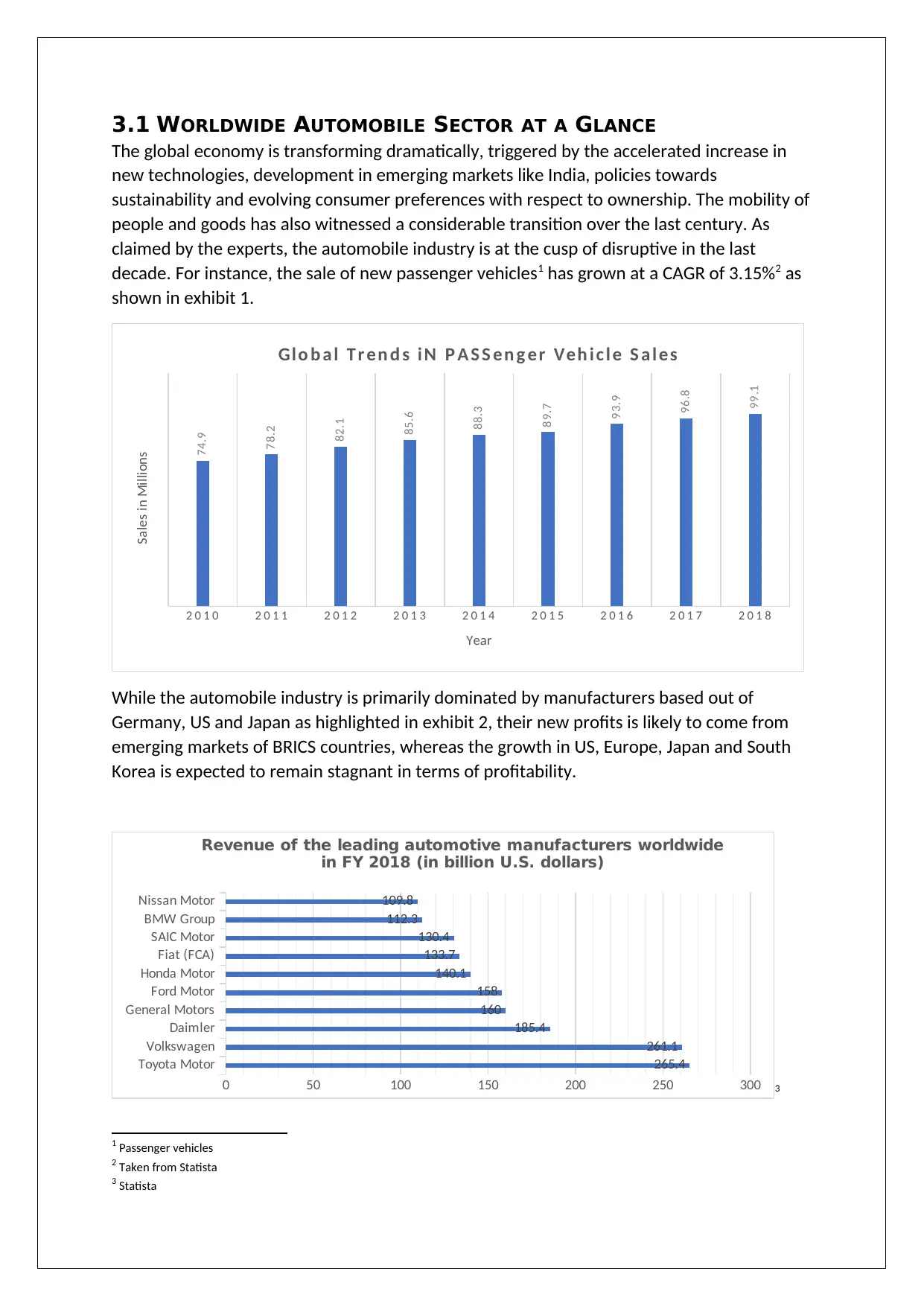
3.1 WORLDWIDE AUTOMOBILE SECTOR AT A GLANCE
The global economy is transforming dramatically, triggered by the accelerated increase in
new technologies, development in emerging markets like India, policies towards
sustainability and evolving consumer preferences with respect to ownership. The mobility of
people and goods has also witnessed a considerable transition over the last century. As
claimed by the experts, the automobile industry is at the cusp of disruptive in the last
decade. For instance, the sale of new passenger vehicles1 has grown at a CAGR of 3.15%2 as
shown in exhibit 1.
2 0 1 0 2 0 1 1 2 0 1 2 2 0 1 3 2 0 1 4 2 0 1 5 2 0 1 6 2 0 1 7 2 0 1 8
74.9
78.2
82.1
85.6
88.3
89.7
93.9
96.8
99.1
Glo b a l T r en d s i N P A S S en g er Veh i c l e S a l es
Year
Sales in Millions
While the automobile industry is primarily dominated by manufacturers based out of
Germany, US and Japan as highlighted in exhibit 2, their new profits is likely to come from
emerging markets of BRICS countries, whereas the growth in US, Europe, Japan and South
Korea is expected to remain stagnant in terms of profitability.
Toyota Motor
Volkswagen
Daimler
General Motors
Ford Motor
Honda Motor
Fiat (FCA)
SAIC Motor
BMW Group
Nissan Motor
0 50 100 150 200 250 300
265.4
261.1
185.4
160
158
140.1
133.7
130.4
112.3
109.8
Revenue of the leading automotive manufacturers worldwide
in FY 2018 (in billion U.S. dollars)
3
1 Passenger vehicles
2 Taken from Statista
3 Statista
The global economy is transforming dramatically, triggered by the accelerated increase in
new technologies, development in emerging markets like India, policies towards
sustainability and evolving consumer preferences with respect to ownership. The mobility of
people and goods has also witnessed a considerable transition over the last century. As
claimed by the experts, the automobile industry is at the cusp of disruptive in the last
decade. For instance, the sale of new passenger vehicles1 has grown at a CAGR of 3.15%2 as
shown in exhibit 1.
2 0 1 0 2 0 1 1 2 0 1 2 2 0 1 3 2 0 1 4 2 0 1 5 2 0 1 6 2 0 1 7 2 0 1 8
74.9
78.2
82.1
85.6
88.3
89.7
93.9
96.8
99.1
Glo b a l T r en d s i N P A S S en g er Veh i c l e S a l es
Year
Sales in Millions
While the automobile industry is primarily dominated by manufacturers based out of
Germany, US and Japan as highlighted in exhibit 2, their new profits is likely to come from
emerging markets of BRICS countries, whereas the growth in US, Europe, Japan and South
Korea is expected to remain stagnant in terms of profitability.
Toyota Motor
Volkswagen
Daimler
General Motors
Ford Motor
Honda Motor
Fiat (FCA)
SAIC Motor
BMW Group
Nissan Motor
0 50 100 150 200 250 300
265.4
261.1
185.4
160
158
140.1
133.7
130.4
112.3
109.8
Revenue of the leading automotive manufacturers worldwide
in FY 2018 (in billion U.S. dollars)
3
1 Passenger vehicles
2 Taken from Statista
3 Statista
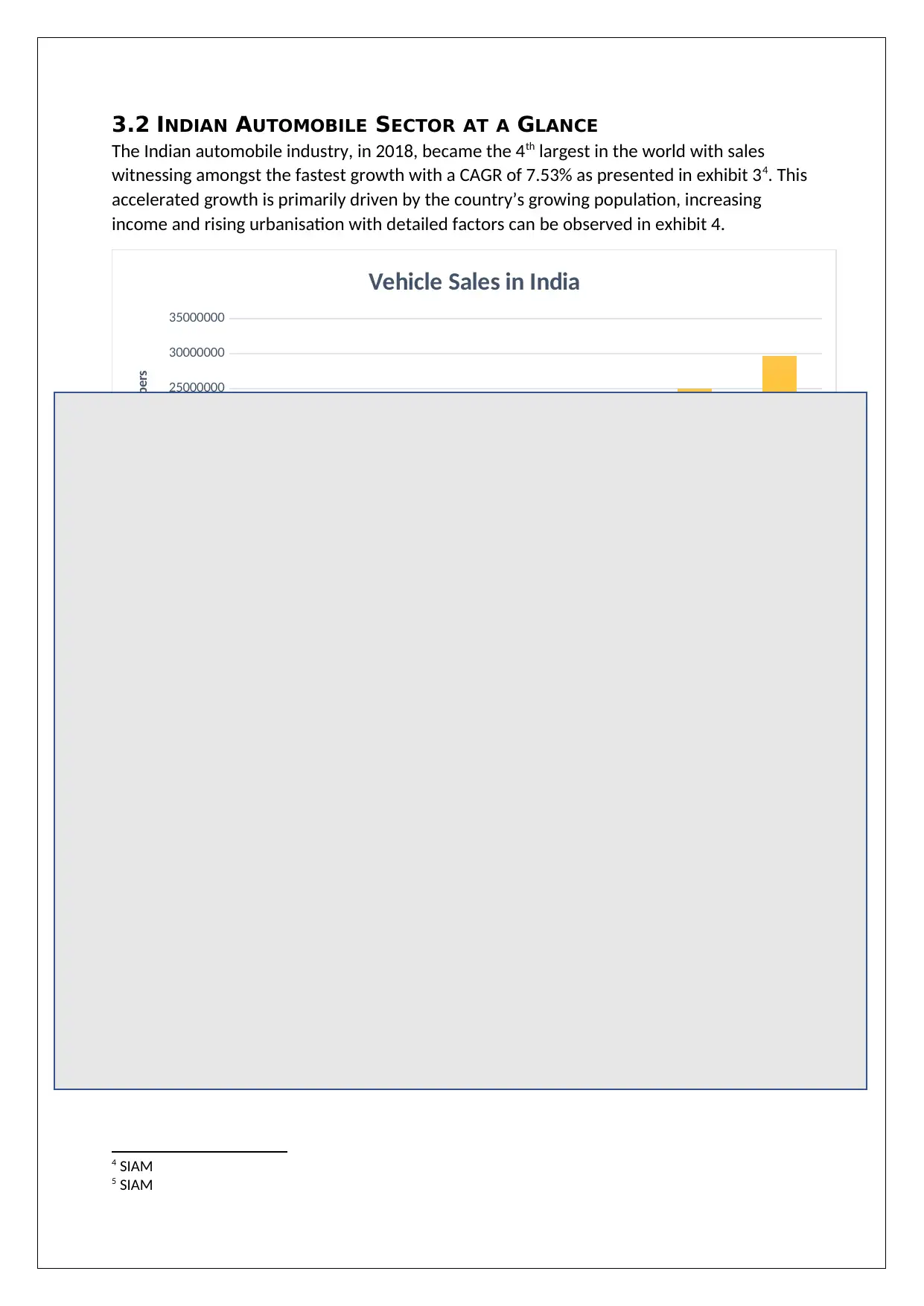
3.2 INDIAN AUTOMOBILE SECTOR AT A GLANCE
The Indian automobile industry, in 2018, became the 4th largest in the world with sales
witnessing amongst the fastest growth with a CAGR of 7.53% as presented in exhibit 34. This
accelerated growth is primarily driven by the country’s growing population, increasing
income and rising urbanisation with detailed factors can be observed in exhibit 4.
2012 2013 2014 2015 2016 2017 2018
0
5000000
10000000
15000000
20000000
25000000
30000000
35000000
Vehicle Sales in India
Passenger Vehicles Commercial Vehicles Three Wheelers Two Wheelers
Year
Sales in Absolute Numbers
The two wheelers have the maximum market share in sales volume as can be observed in Exhibit 45.
While the sales of passenger vehicles in India have constituted to about 2.9%-3.5% of the world’s
share, the Indian market has emerged as the biggest market for two and three-wheelers. This
growth is attributed to the massive spending by the Indian Government in rural programmes and
large road-construction, leading to an accelerated pick up sales volume in smaller towns and villages.
12 3 2
83
Percentage Share of Vehicle Sales in 2018
Passenger Vehicles Commercial Vehicles
Three Wheelers Two Wheelers
4 SIAM
5 SIAM
The Indian automobile industry, in 2018, became the 4th largest in the world with sales
witnessing amongst the fastest growth with a CAGR of 7.53% as presented in exhibit 34. This
accelerated growth is primarily driven by the country’s growing population, increasing
income and rising urbanisation with detailed factors can be observed in exhibit 4.
2012 2013 2014 2015 2016 2017 2018
0
5000000
10000000
15000000
20000000
25000000
30000000
35000000
Vehicle Sales in India
Passenger Vehicles Commercial Vehicles Three Wheelers Two Wheelers
Year
Sales in Absolute Numbers
The two wheelers have the maximum market share in sales volume as can be observed in Exhibit 45.
While the sales of passenger vehicles in India have constituted to about 2.9%-3.5% of the world’s
share, the Indian market has emerged as the biggest market for two and three-wheelers. This
growth is attributed to the massive spending by the Indian Government in rural programmes and
large road-construction, leading to an accelerated pick up sales volume in smaller towns and villages.
12 3 2
83
Percentage Share of Vehicle Sales in 2018
Passenger Vehicles Commercial Vehicles
Three Wheelers Two Wheelers
4 SIAM
5 SIAM
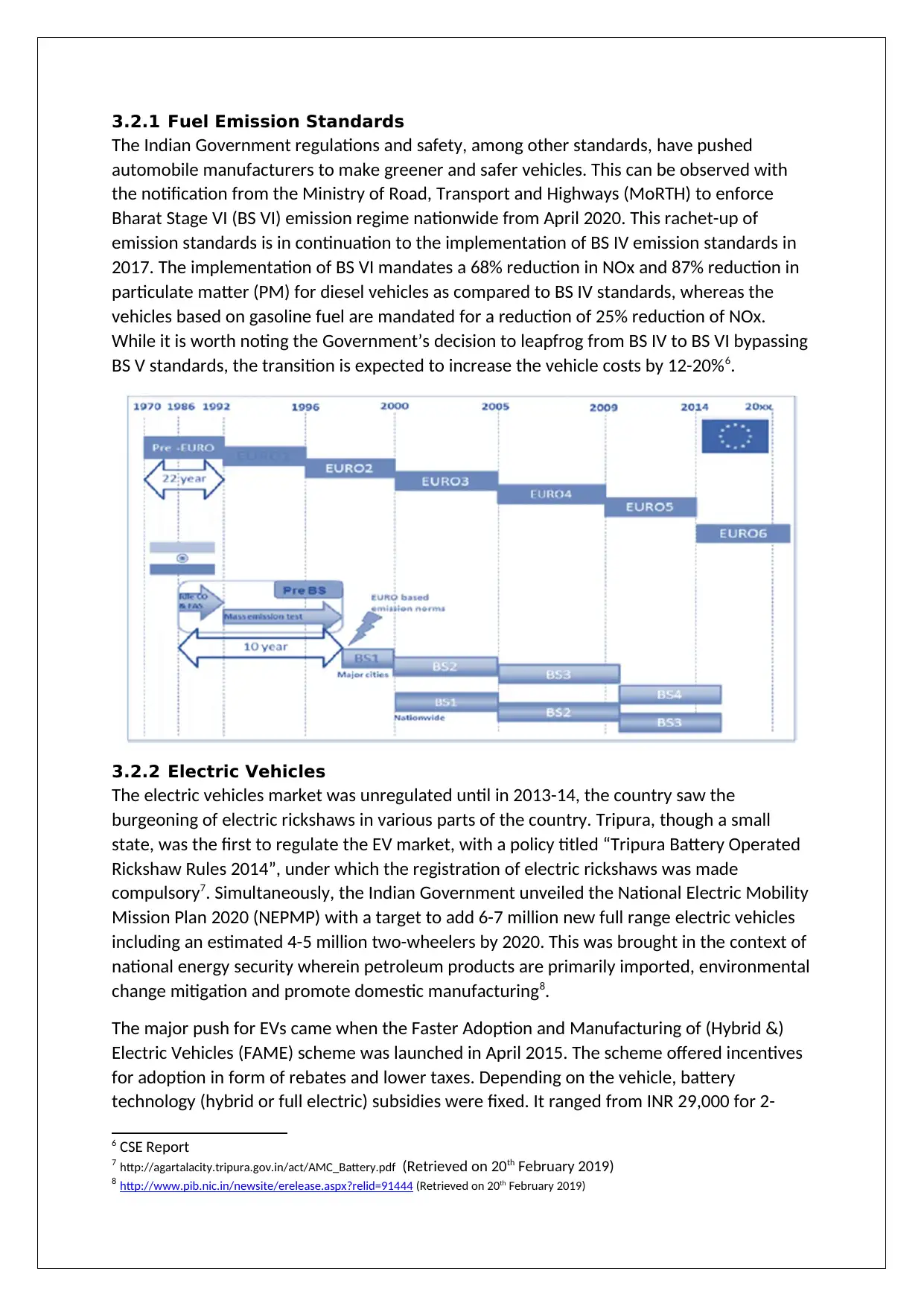
3.2.1 Fuel Emission Standards
The Indian Government regulations and safety, among other standards, have pushed
automobile manufacturers to make greener and safer vehicles. This can be observed with
the notification from the Ministry of Road, Transport and Highways (MoRTH) to enforce
Bharat Stage VI (BS VI) emission regime nationwide from April 2020. This rachet-up of
emission standards is in continuation to the implementation of BS IV emission standards in
2017. The implementation of BS VI mandates a 68% reduction in NOx and 87% reduction in
particulate matter (PM) for diesel vehicles as compared to BS IV standards, whereas the
vehicles based on gasoline fuel are mandated for a reduction of 25% reduction of NOx.
While it is worth noting the Government’s decision to leapfrog from BS IV to BS VI bypassing
BS V standards, the transition is expected to increase the vehicle costs by 12-20%6.
3.2.2 Electric Vehicles
The electric vehicles market was unregulated until in 2013-14, the country saw the
burgeoning of electric rickshaws in various parts of the country. Tripura, though a small
state, was the first to regulate the EV market, with a policy titled “Tripura Battery Operated
Rickshaw Rules 2014”, under which the registration of electric rickshaws was made
compulsory7. Simultaneously, the Indian Government unveiled the National Electric Mobility
Mission Plan 2020 (NEPMP) with a target to add 6-7 million new full range electric vehicles
including an estimated 4-5 million two-wheelers by 2020. This was brought in the context of
national energy security wherein petroleum products are primarily imported, environmental
change mitigation and promote domestic manufacturing8.
The major push for EVs came when the Faster Adoption and Manufacturing of (Hybrid &)
Electric Vehicles (FAME) scheme was launched in April 2015. The scheme offered incentives
for adoption in form of rebates and lower taxes. Depending on the vehicle, battery
technology (hybrid or full electric) subsidies were fixed. It ranged from INR 29,000 for 2-
6 CSE Report
7 http://agartalacity.tripura.gov.in/act/AMC_Battery.pdf (Retrieved on 20th February 2019)
8 http://www.pib.nic.in/newsite/erelease.aspx?relid=91444 (Retrieved on 20th February 2019)
The Indian Government regulations and safety, among other standards, have pushed
automobile manufacturers to make greener and safer vehicles. This can be observed with
the notification from the Ministry of Road, Transport and Highways (MoRTH) to enforce
Bharat Stage VI (BS VI) emission regime nationwide from April 2020. This rachet-up of
emission standards is in continuation to the implementation of BS IV emission standards in
2017. The implementation of BS VI mandates a 68% reduction in NOx and 87% reduction in
particulate matter (PM) for diesel vehicles as compared to BS IV standards, whereas the
vehicles based on gasoline fuel are mandated for a reduction of 25% reduction of NOx.
While it is worth noting the Government’s decision to leapfrog from BS IV to BS VI bypassing
BS V standards, the transition is expected to increase the vehicle costs by 12-20%6.
3.2.2 Electric Vehicles
The electric vehicles market was unregulated until in 2013-14, the country saw the
burgeoning of electric rickshaws in various parts of the country. Tripura, though a small
state, was the first to regulate the EV market, with a policy titled “Tripura Battery Operated
Rickshaw Rules 2014”, under which the registration of electric rickshaws was made
compulsory7. Simultaneously, the Indian Government unveiled the National Electric Mobility
Mission Plan 2020 (NEPMP) with a target to add 6-7 million new full range electric vehicles
including an estimated 4-5 million two-wheelers by 2020. This was brought in the context of
national energy security wherein petroleum products are primarily imported, environmental
change mitigation and promote domestic manufacturing8.
The major push for EVs came when the Faster Adoption and Manufacturing of (Hybrid &)
Electric Vehicles (FAME) scheme was launched in April 2015. The scheme offered incentives
for adoption in form of rebates and lower taxes. Depending on the vehicle, battery
technology (hybrid or full electric) subsidies were fixed. It ranged from INR 29,000 for 2-
6 CSE Report
7 http://agartalacity.tripura.gov.in/act/AMC_Battery.pdf (Retrieved on 20th February 2019)
8 http://www.pib.nic.in/newsite/erelease.aspx?relid=91444 (Retrieved on 20th February 2019)
Secure Best Marks with AI Grader
Need help grading? Try our AI Grader for instant feedback on your assignments.
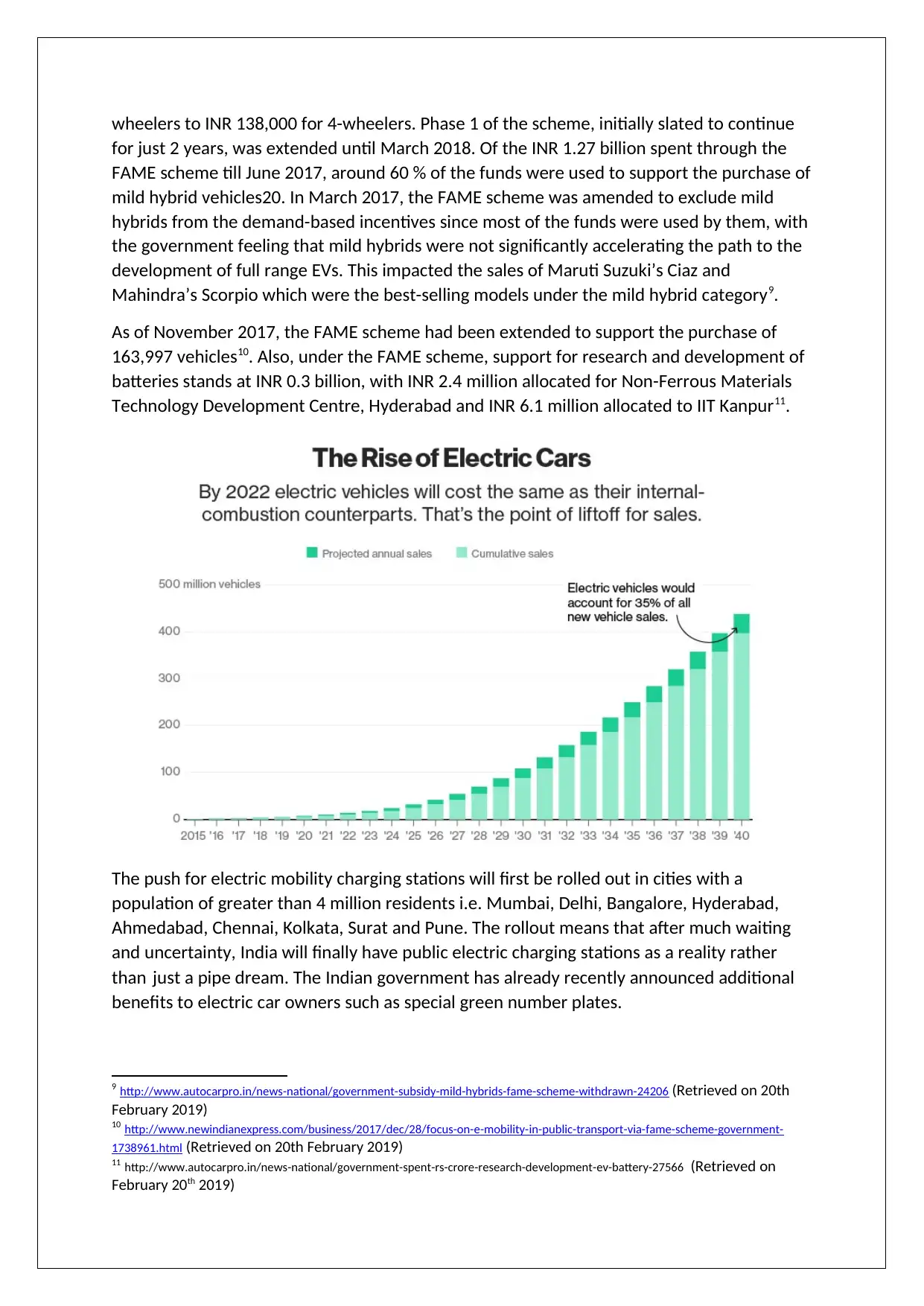
wheelers to INR 138,000 for 4-wheelers. Phase 1 of the scheme, initially slated to continue
for just 2 years, was extended until March 2018. Of the INR 1.27 billion spent through the
FAME scheme till June 2017, around 60 % of the funds were used to support the purchase of
mild hybrid vehicles20. In March 2017, the FAME scheme was amended to exclude mild
hybrids from the demand-based incentives since most of the funds were used by them, with
the government feeling that mild hybrids were not significantly accelerating the path to the
development of full range EVs. This impacted the sales of Maruti Suzuki’s Ciaz and
Mahindra’s Scorpio which were the best-selling models under the mild hybrid category9.
As of November 2017, the FAME scheme had been extended to support the purchase of
163,997 vehicles10. Also, under the FAME scheme, support for research and development of
batteries stands at INR 0.3 billion, with INR 2.4 million allocated for Non-Ferrous Materials
Technology Development Centre, Hyderabad and INR 6.1 million allocated to IIT Kanpur11.
The push for electric mobility charging stations will first be rolled out in cities with a
population of greater than 4 million residents i.e. Mumbai, Delhi, Bangalore, Hyderabad,
Ahmedabad, Chennai, Kolkata, Surat and Pune. The rollout means that after much waiting
and uncertainty, India will finally have public electric charging stations as a reality rather
than just a pipe dream. The Indian government has already recently announced additional
benefits to electric car owners such as special green number plates.
9 http://www.autocarpro.in/news-national/government-subsidy-mild-hybrids-fame-scheme-withdrawn-24206 (Retrieved on 20th
February 2019)
10 http://www.newindianexpress.com/business/2017/dec/28/focus-on-e-mobility-in-public-transport-via-fame-scheme-government-
1738961.html (Retrieved on 20th February 2019)
11 http://www.autocarpro.in/news-national/government-spent-rs-crore-research-development-ev-battery-27566 (Retrieved on
February 20th 2019)
for just 2 years, was extended until March 2018. Of the INR 1.27 billion spent through the
FAME scheme till June 2017, around 60 % of the funds were used to support the purchase of
mild hybrid vehicles20. In March 2017, the FAME scheme was amended to exclude mild
hybrids from the demand-based incentives since most of the funds were used by them, with
the government feeling that mild hybrids were not significantly accelerating the path to the
development of full range EVs. This impacted the sales of Maruti Suzuki’s Ciaz and
Mahindra’s Scorpio which were the best-selling models under the mild hybrid category9.
As of November 2017, the FAME scheme had been extended to support the purchase of
163,997 vehicles10. Also, under the FAME scheme, support for research and development of
batteries stands at INR 0.3 billion, with INR 2.4 million allocated for Non-Ferrous Materials
Technology Development Centre, Hyderabad and INR 6.1 million allocated to IIT Kanpur11.
The push for electric mobility charging stations will first be rolled out in cities with a
population of greater than 4 million residents i.e. Mumbai, Delhi, Bangalore, Hyderabad,
Ahmedabad, Chennai, Kolkata, Surat and Pune. The rollout means that after much waiting
and uncertainty, India will finally have public electric charging stations as a reality rather
than just a pipe dream. The Indian government has already recently announced additional
benefits to electric car owners such as special green number plates.
9 http://www.autocarpro.in/news-national/government-subsidy-mild-hybrids-fame-scheme-withdrawn-24206 (Retrieved on 20th
February 2019)
10 http://www.newindianexpress.com/business/2017/dec/28/focus-on-e-mobility-in-public-transport-via-fame-scheme-government-
1738961.html (Retrieved on 20th February 2019)
11 http://www.autocarpro.in/news-national/government-spent-rs-crore-research-development-ev-battery-27566 (Retrieved on
February 20th 2019)
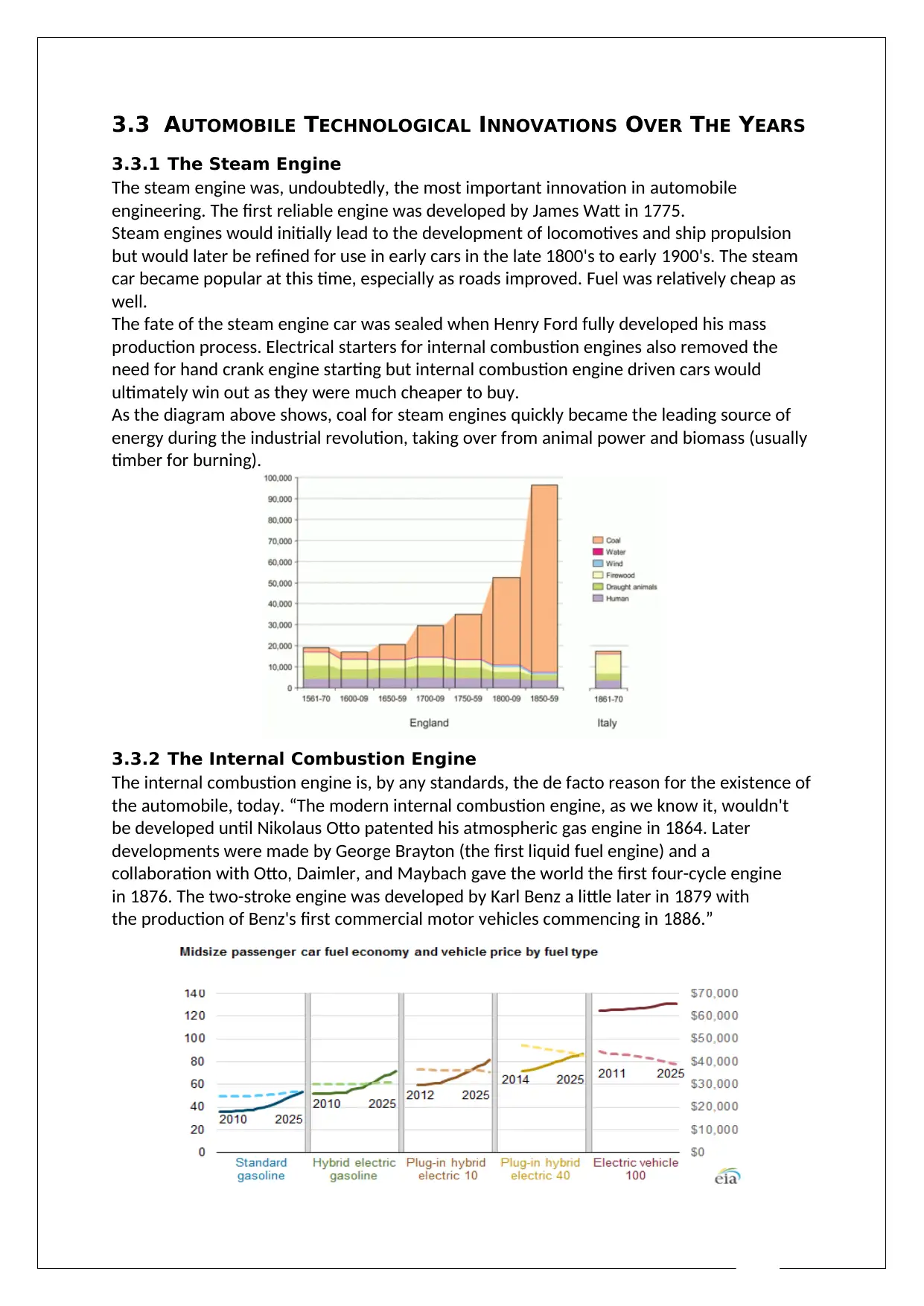
3.3 AUTOMOBILE TECHNOLOGICAL INNOVATIONS OVER THE YEARS
3.3.1 The Steam Engine
The steam engine was, undoubtedly, the most important innovation in automobile
engineering. The first reliable engine was developed by James Watt in 1775.
Steam engines would initially lead to the development of locomotives and ship propulsion
but would later be refined for use in early cars in the late 1800's to early 1900's. The steam
car became popular at this time, especially as roads improved. Fuel was relatively cheap as
well.
The fate of the steam engine car was sealed when Henry Ford fully developed his mass
production process. Electrical starters for internal combustion engines also removed the
need for hand crank engine starting but internal combustion engine driven cars would
ultimately win out as they were much cheaper to buy.
As the diagram above shows, coal for steam engines quickly became the leading source of
energy during the industrial revolution, taking over from animal power and biomass (usually
timber for burning).
3.3.2 The Internal Combustion Engine
The internal combustion engine is, by any standards, the de facto reason for the existence of
the automobile, today. “The modern internal combustion engine, as we know it, wouldn't
be developed until Nikolaus Otto patented his atmospheric gas engine in 1864. Later
developments were made by George Brayton (the first liquid fuel engine) and a
collaboration with Otto, Daimler, and Maybach gave the world the first four-cycle engine
in 1876. The two-stroke engine was developed by Karl Benz a little later in 1879 with
the production of Benz's first commercial motor vehicles commencing in 1886.”
3.3.1 The Steam Engine
The steam engine was, undoubtedly, the most important innovation in automobile
engineering. The first reliable engine was developed by James Watt in 1775.
Steam engines would initially lead to the development of locomotives and ship propulsion
but would later be refined for use in early cars in the late 1800's to early 1900's. The steam
car became popular at this time, especially as roads improved. Fuel was relatively cheap as
well.
The fate of the steam engine car was sealed when Henry Ford fully developed his mass
production process. Electrical starters for internal combustion engines also removed the
need for hand crank engine starting but internal combustion engine driven cars would
ultimately win out as they were much cheaper to buy.
As the diagram above shows, coal for steam engines quickly became the leading source of
energy during the industrial revolution, taking over from animal power and biomass (usually
timber for burning).
3.3.2 The Internal Combustion Engine
The internal combustion engine is, by any standards, the de facto reason for the existence of
the automobile, today. “The modern internal combustion engine, as we know it, wouldn't
be developed until Nikolaus Otto patented his atmospheric gas engine in 1864. Later
developments were made by George Brayton (the first liquid fuel engine) and a
collaboration with Otto, Daimler, and Maybach gave the world the first four-cycle engine
in 1876. The two-stroke engine was developed by Karl Benz a little later in 1879 with
the production of Benz's first commercial motor vehicles commencing in 1886.”

3.3.3 The Diesel Engine
The Diesel engine, or compression-ignition (CI Engine), was developed by Rudolf Diesel and
is still today the highest thermal efficiency of any practical internal combustion engine. In
some cases, low-speed diesel engines can have a thermal efficiency of just over 50%.
“As the name suggests, ignition of the fuel is accomplished by mechanical compression of
the air in the combustion chamber to such a degree that injected atomized diesel ignites
instantaneously (adiabatic compression). This contrasts with spark ignition of petrol or gas
engines.”
3.3.4 Automatic Transmission
Automatic transmission, auto or self-shifting transmission is another great innovation in
automobile engineering. The automated system frees the driver from the need to change
gear ratios manually as the vehicle is on the move.
This innovation, immediately reduced the number of controls that a driver needs to use to
control the automobile. It was originally developed in 1921 by Alfred Horner Munro, a
Canadian. He patented his design in 1923 and acquired UK and US patents in 1924 and
1927 respectively.
3.3.5 Power Steering
Power Steering or power-assisted steering (PAS) is another great innovation in automobile
engineering that helps drivers steer their cars. Having this, drivers need to exert much less
The Diesel engine, or compression-ignition (CI Engine), was developed by Rudolf Diesel and
is still today the highest thermal efficiency of any practical internal combustion engine. In
some cases, low-speed diesel engines can have a thermal efficiency of just over 50%.
“As the name suggests, ignition of the fuel is accomplished by mechanical compression of
the air in the combustion chamber to such a degree that injected atomized diesel ignites
instantaneously (adiabatic compression). This contrasts with spark ignition of petrol or gas
engines.”
3.3.4 Automatic Transmission
Automatic transmission, auto or self-shifting transmission is another great innovation in
automobile engineering. The automated system frees the driver from the need to change
gear ratios manually as the vehicle is on the move.
This innovation, immediately reduced the number of controls that a driver needs to use to
control the automobile. It was originally developed in 1921 by Alfred Horner Munro, a
Canadian. He patented his design in 1923 and acquired UK and US patents in 1924 and
1927 respectively.
3.3.5 Power Steering
Power Steering or power-assisted steering (PAS) is another great innovation in automobile
engineering that helps drivers steer their cars. Having this, drivers need to exert much less
Paraphrase This Document
Need a fresh take? Get an instant paraphrase of this document with our AI Paraphraser
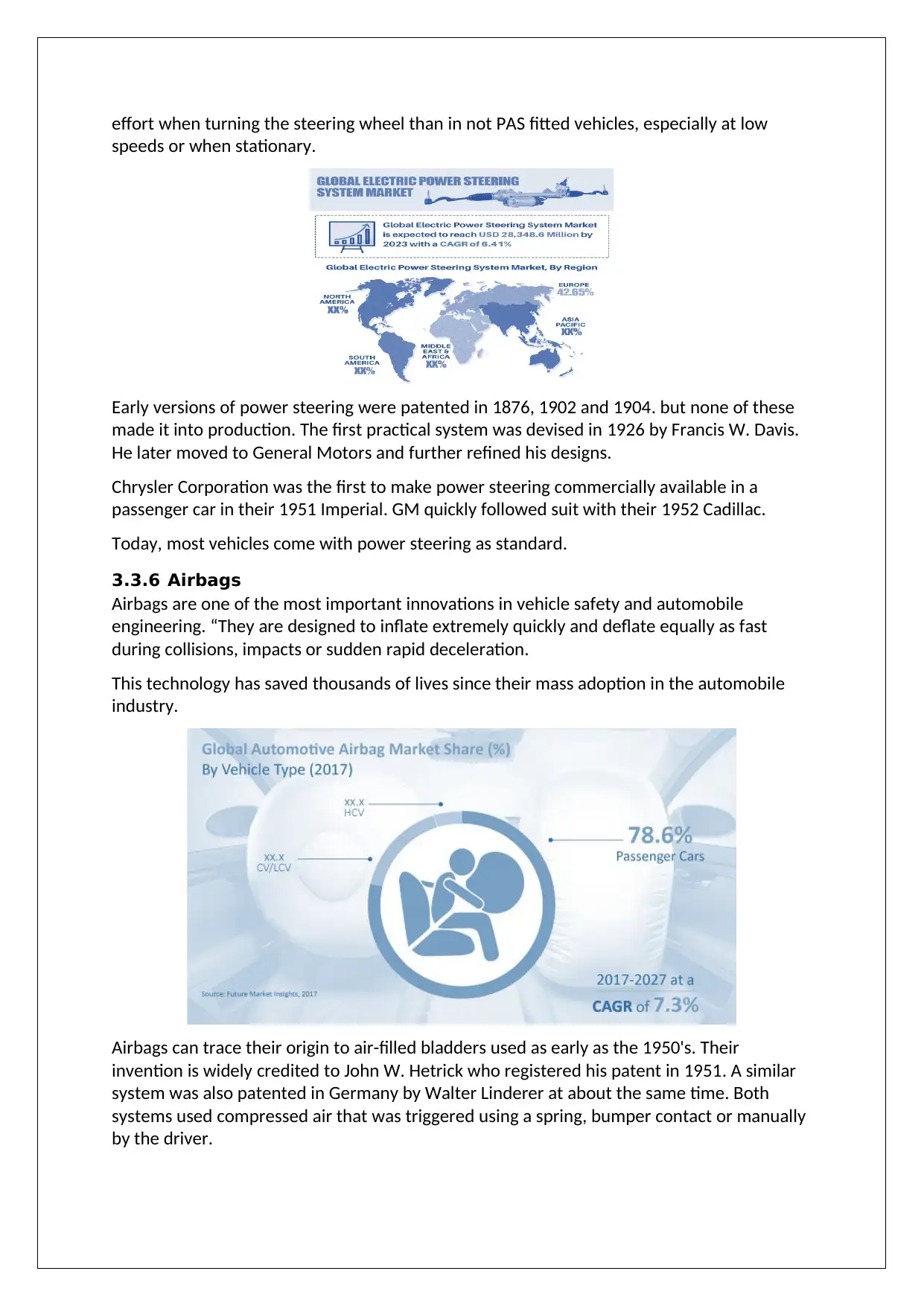
effort when turning the steering wheel than in not PAS fitted vehicles, especially at low
speeds or when stationary.
Early versions of power steering were patented in 1876, 1902 and 1904. but none of these
made it into production. The first practical system was devised in 1926 by Francis W. Davis.
He later moved to General Motors and further refined his designs.
Chrysler Corporation was the first to make power steering commercially available in a
passenger car in their 1951 Imperial. GM quickly followed suit with their 1952 Cadillac.
Today, most vehicles come with power steering as standard.
3.3.6 Airbags
Airbags are one of the most important innovations in vehicle safety and automobile
engineering. “They are designed to inflate extremely quickly and deflate equally as fast
during collisions, impacts or sudden rapid deceleration.
This technology has saved thousands of lives since their mass adoption in the automobile
industry.
Airbags can trace their origin to air-filled bladders used as early as the 1950's. Their
invention is widely credited to John W. Hetrick who registered his patent in 1951. A similar
system was also patented in Germany by Walter Linderer at about the same time. Both
systems used compressed air that was triggered using a spring, bumper contact or manually
by the driver.
speeds or when stationary.
Early versions of power steering were patented in 1876, 1902 and 1904. but none of these
made it into production. The first practical system was devised in 1926 by Francis W. Davis.
He later moved to General Motors and further refined his designs.
Chrysler Corporation was the first to make power steering commercially available in a
passenger car in their 1951 Imperial. GM quickly followed suit with their 1952 Cadillac.
Today, most vehicles come with power steering as standard.
3.3.6 Airbags
Airbags are one of the most important innovations in vehicle safety and automobile
engineering. “They are designed to inflate extremely quickly and deflate equally as fast
during collisions, impacts or sudden rapid deceleration.
This technology has saved thousands of lives since their mass adoption in the automobile
industry.
Airbags can trace their origin to air-filled bladders used as early as the 1950's. Their
invention is widely credited to John W. Hetrick who registered his patent in 1951. A similar
system was also patented in Germany by Walter Linderer at about the same time. Both
systems used compressed air that was triggered using a spring, bumper contact or manually
by the driver.
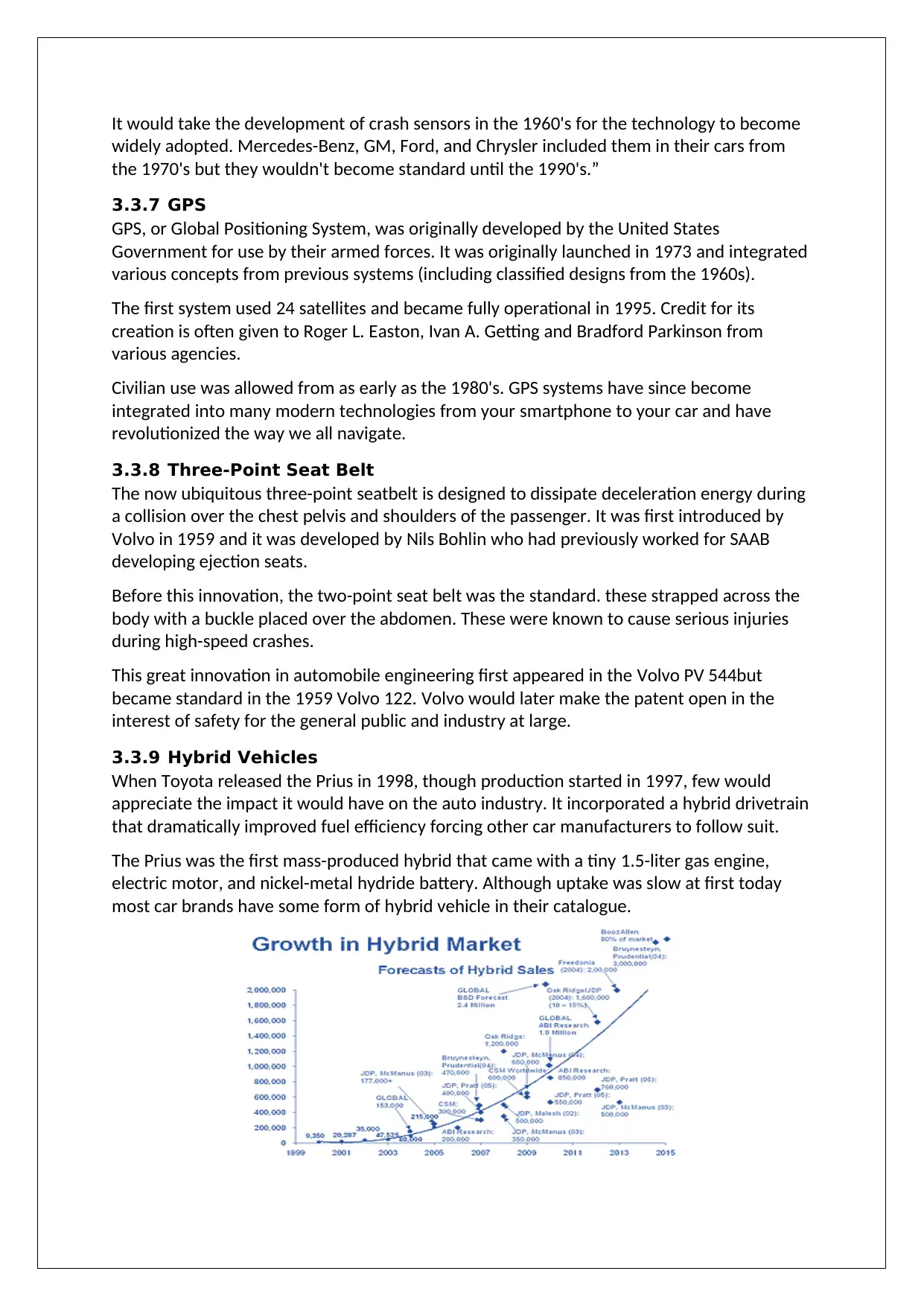
It would take the development of crash sensors in the 1960's for the technology to become
widely adopted. Mercedes-Benz, GM, Ford, and Chrysler included them in their cars from
the 1970's but they wouldn't become standard until the 1990's.”
3.3.7 GPS
GPS, or Global Positioning System, was originally developed by the United States
Government for use by their armed forces. It was originally launched in 1973 and integrated
various concepts from previous systems (including classified designs from the 1960s).
The first system used 24 satellites and became fully operational in 1995. Credit for its
creation is often given to Roger L. Easton, Ivan A. Getting and Bradford Parkinson from
various agencies.
Civilian use was allowed from as early as the 1980's. GPS systems have since become
integrated into many modern technologies from your smartphone to your car and have
revolutionized the way we all navigate.
3.3.8 Three-Point Seat Belt
The now ubiquitous three-point seatbelt is designed to dissipate deceleration energy during
a collision over the chest pelvis and shoulders of the passenger. It was first introduced by
Volvo in 1959 and it was developed by Nils Bohlin who had previously worked for SAAB
developing ejection seats.
Before this innovation, the two-point seat belt was the standard. these strapped across the
body with a buckle placed over the abdomen. These were known to cause serious injuries
during high-speed crashes.
This great innovation in automobile engineering first appeared in the Volvo PV 544but
became standard in the 1959 Volvo 122. Volvo would later make the patent open in the
interest of safety for the general public and industry at large.
3.3.9 Hybrid Vehicles
When Toyota released the Prius in 1998, though production started in 1997, few would
appreciate the impact it would have on the auto industry. It incorporated a hybrid drivetrain
that dramatically improved fuel efficiency forcing other car manufacturers to follow suit.
The Prius was the first mass-produced hybrid that came with a tiny 1.5-liter gas engine,
electric motor, and nickel-metal hydride battery. Although uptake was slow at first today
most car brands have some form of hybrid vehicle in their catalogue.
widely adopted. Mercedes-Benz, GM, Ford, and Chrysler included them in their cars from
the 1970's but they wouldn't become standard until the 1990's.”
3.3.7 GPS
GPS, or Global Positioning System, was originally developed by the United States
Government for use by their armed forces. It was originally launched in 1973 and integrated
various concepts from previous systems (including classified designs from the 1960s).
The first system used 24 satellites and became fully operational in 1995. Credit for its
creation is often given to Roger L. Easton, Ivan A. Getting and Bradford Parkinson from
various agencies.
Civilian use was allowed from as early as the 1980's. GPS systems have since become
integrated into many modern technologies from your smartphone to your car and have
revolutionized the way we all navigate.
3.3.8 Three-Point Seat Belt
The now ubiquitous three-point seatbelt is designed to dissipate deceleration energy during
a collision over the chest pelvis and shoulders of the passenger. It was first introduced by
Volvo in 1959 and it was developed by Nils Bohlin who had previously worked for SAAB
developing ejection seats.
Before this innovation, the two-point seat belt was the standard. these strapped across the
body with a buckle placed over the abdomen. These were known to cause serious injuries
during high-speed crashes.
This great innovation in automobile engineering first appeared in the Volvo PV 544but
became standard in the 1959 Volvo 122. Volvo would later make the patent open in the
interest of safety for the general public and industry at large.
3.3.9 Hybrid Vehicles
When Toyota released the Prius in 1998, though production started in 1997, few would
appreciate the impact it would have on the auto industry. It incorporated a hybrid drivetrain
that dramatically improved fuel efficiency forcing other car manufacturers to follow suit.
The Prius was the first mass-produced hybrid that came with a tiny 1.5-liter gas engine,
electric motor, and nickel-metal hydride battery. Although uptake was slow at first today
most car brands have some form of hybrid vehicle in their catalogue.

3.4 FUTURE TRENDS AND GROWTH OUTLOOK
The future of the automobile industry is very exciting. Automobiles are becoming large,
beautiful and smart devices with advanced emergency braking capabilities, mapping
technology for autonomous driving, better fuel efficiency and cars as a service as a form of
transportation. The future of this industry is ACES- Automation, Connected, Electrified and
Shared.
3.4.1 Autonomous Vehicles
Autonomous Vehicles are the future of the automobile sector in India and the world. Having
evolved from, “Impossible” to “When can we see them on roads”, they have come a long
way. Here is the autonomous evolution over the years:
As Techopedia defines it, “An autonomous car is a vehicle that can guide itself without
human conduction. This kind of vehicle has become a concrete reality and may pave the
way for future systems where computers take over the art of driving. An autonomous car is
also known as a driverless car, robot car, self-driving car or autonomous vehicle.”
The future of the automobile industry is very exciting. Automobiles are becoming large,
beautiful and smart devices with advanced emergency braking capabilities, mapping
technology for autonomous driving, better fuel efficiency and cars as a service as a form of
transportation. The future of this industry is ACES- Automation, Connected, Electrified and
Shared.
3.4.1 Autonomous Vehicles
Autonomous Vehicles are the future of the automobile sector in India and the world. Having
evolved from, “Impossible” to “When can we see them on roads”, they have come a long
way. Here is the autonomous evolution over the years:
As Techopedia defines it, “An autonomous car is a vehicle that can guide itself without
human conduction. This kind of vehicle has become a concrete reality and may pave the
way for future systems where computers take over the art of driving. An autonomous car is
also known as a driverless car, robot car, self-driving car or autonomous vehicle.”
Secure Best Marks with AI Grader
Need help grading? Try our AI Grader for instant feedback on your assignments.
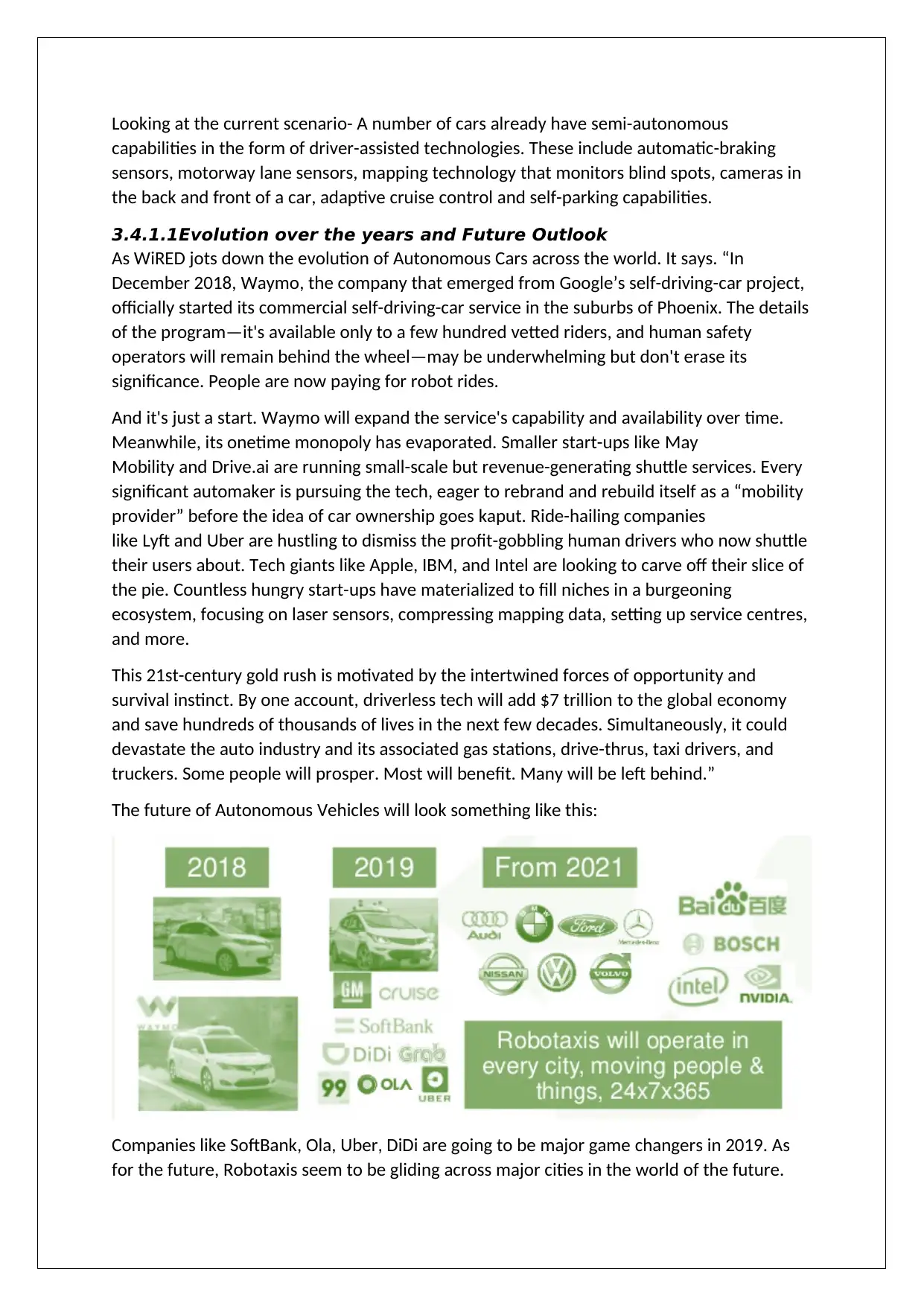
Looking at the current scenario- A number of cars already have semi-autonomous
capabilities in the form of driver-assisted technologies. These include automatic-braking
sensors, motorway lane sensors, mapping technology that monitors blind spots, cameras in
the back and front of a car, adaptive cruise control and self-parking capabilities.
3.4.1.1Evolution over the years and Future Outlook
As WiRED jots down the evolution of Autonomous Cars across the world. It says. “In
December 2018, Waymo, the company that emerged from Google’s self-driving-car project,
officially started its commercial self-driving-car service in the suburbs of Phoenix. The details
of the program—it's available only to a few hundred vetted riders, and human safety
operators will remain behind the wheel—may be underwhelming but don't erase its
significance. People are now paying for robot rides.
And it's just a start. Waymo will expand the service's capability and availability over time.
Meanwhile, its onetime monopoly has evaporated. Smaller start-ups like May
Mobility and Drive.ai are running small-scale but revenue-generating shuttle services. Every
significant automaker is pursuing the tech, eager to rebrand and rebuild itself as a “mobility
provider” before the idea of car ownership goes kaput. Ride-hailing companies
like Lyft and Uber are hustling to dismiss the profit-gobbling human drivers who now shuttle
their users about. Tech giants like Apple, IBM, and Intel are looking to carve off their slice of
the pie. Countless hungry start-ups have materialized to fill niches in a burgeoning
ecosystem, focusing on laser sensors, compressing mapping data, setting up service centres,
and more.
This 21st-century gold rush is motivated by the intertwined forces of opportunity and
survival instinct. By one account, driverless tech will add $7 trillion to the global economy
and save hundreds of thousands of lives in the next few decades. Simultaneously, it could
devastate the auto industry and its associated gas stations, drive-thrus, taxi drivers, and
truckers. Some people will prosper. Most will benefit. Many will be left behind.”
The future of Autonomous Vehicles will look something like this:
Companies like SoftBank, Ola, Uber, DiDi are going to be major game changers in 2019. As
for the future, Robotaxis seem to be gliding across major cities in the world of the future.
capabilities in the form of driver-assisted technologies. These include automatic-braking
sensors, motorway lane sensors, mapping technology that monitors blind spots, cameras in
the back and front of a car, adaptive cruise control and self-parking capabilities.
3.4.1.1Evolution over the years and Future Outlook
As WiRED jots down the evolution of Autonomous Cars across the world. It says. “In
December 2018, Waymo, the company that emerged from Google’s self-driving-car project,
officially started its commercial self-driving-car service in the suburbs of Phoenix. The details
of the program—it's available only to a few hundred vetted riders, and human safety
operators will remain behind the wheel—may be underwhelming but don't erase its
significance. People are now paying for robot rides.
And it's just a start. Waymo will expand the service's capability and availability over time.
Meanwhile, its onetime monopoly has evaporated. Smaller start-ups like May
Mobility and Drive.ai are running small-scale but revenue-generating shuttle services. Every
significant automaker is pursuing the tech, eager to rebrand and rebuild itself as a “mobility
provider” before the idea of car ownership goes kaput. Ride-hailing companies
like Lyft and Uber are hustling to dismiss the profit-gobbling human drivers who now shuttle
their users about. Tech giants like Apple, IBM, and Intel are looking to carve off their slice of
the pie. Countless hungry start-ups have materialized to fill niches in a burgeoning
ecosystem, focusing on laser sensors, compressing mapping data, setting up service centres,
and more.
This 21st-century gold rush is motivated by the intertwined forces of opportunity and
survival instinct. By one account, driverless tech will add $7 trillion to the global economy
and save hundreds of thousands of lives in the next few decades. Simultaneously, it could
devastate the auto industry and its associated gas stations, drive-thrus, taxi drivers, and
truckers. Some people will prosper. Most will benefit. Many will be left behind.”
The future of Autonomous Vehicles will look something like this:
Companies like SoftBank, Ola, Uber, DiDi are going to be major game changers in 2019. As
for the future, Robotaxis seem to be gliding across major cities in the world of the future.
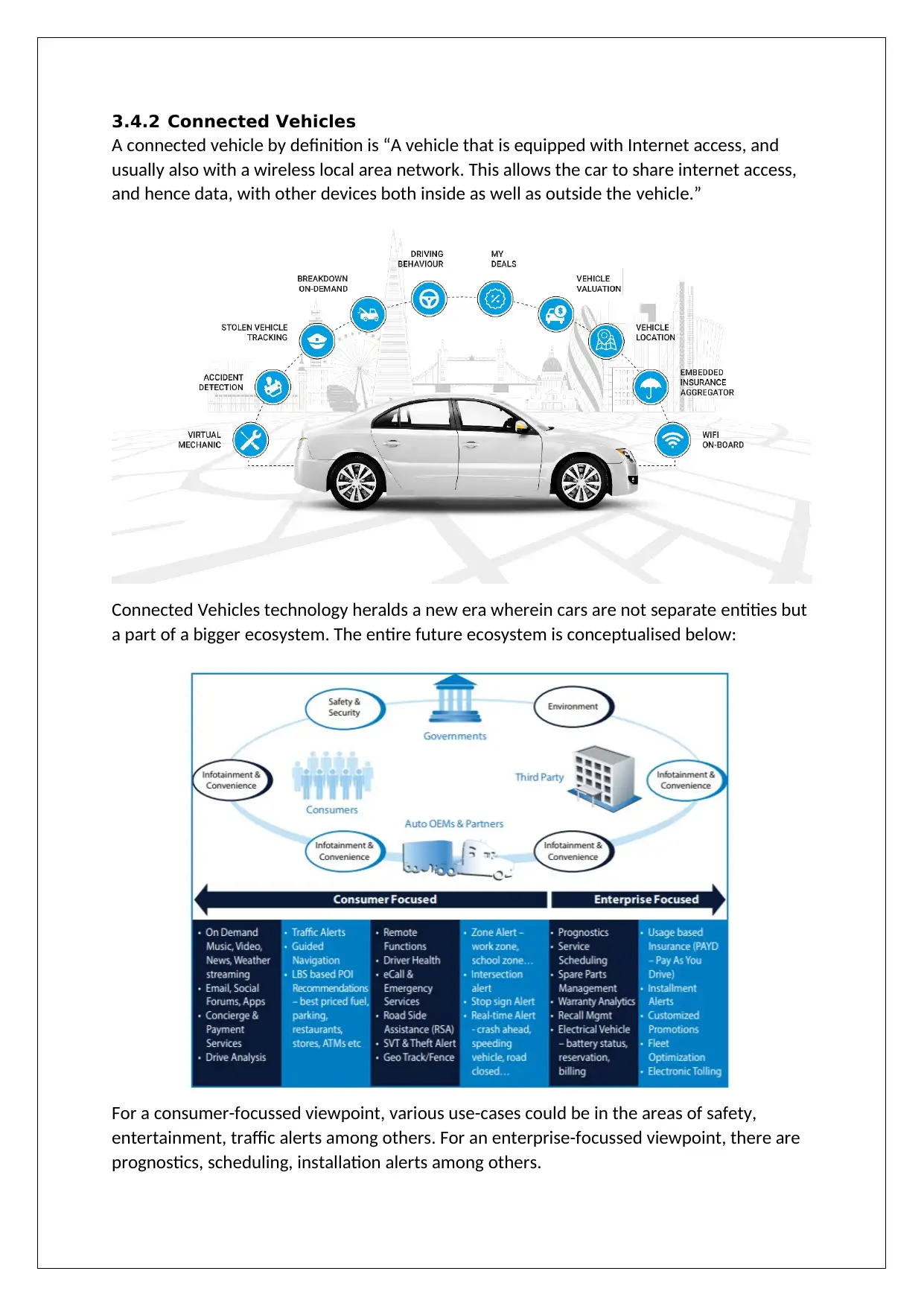
3.4.2 Connected Vehicles
A connected vehicle by definition is “A vehicle that is equipped with Internet access, and
usually also with a wireless local area network. This allows the car to share internet access,
and hence data, with other devices both inside as well as outside the vehicle.”
Connected Vehicles technology heralds a new era wherein cars are not separate entities but
a part of a bigger ecosystem. The entire future ecosystem is conceptualised below:
For a consumer-focussed viewpoint, various use-cases could be in the areas of safety,
entertainment, traffic alerts among others. For an enterprise-focussed viewpoint, there are
prognostics, scheduling, installation alerts among others.
A connected vehicle by definition is “A vehicle that is equipped with Internet access, and
usually also with a wireless local area network. This allows the car to share internet access,
and hence data, with other devices both inside as well as outside the vehicle.”
Connected Vehicles technology heralds a new era wherein cars are not separate entities but
a part of a bigger ecosystem. The entire future ecosystem is conceptualised below:
For a consumer-focussed viewpoint, various use-cases could be in the areas of safety,
entertainment, traffic alerts among others. For an enterprise-focussed viewpoint, there are
prognostics, scheduling, installation alerts among others.

3.4.2.1Connected Vehicles in India
India is a fast-emerging market for connected vehicle business, with telematics developing
quite promisingly in the country. Due to various factors like availability and affordability of
high-speed internet connectivity, smartphone integration via apps, and numerous benefits
through industry offerings, the adoption of telematics is increasing among users. Further, as
OEMs are incorporating advanced telematics solutions in both the passenger cars and
commercial vehicle segments, it is expected to fuel the growth of automotive telematics
ecosystem.
In this context, telematics-enabled mobility is the key to the implementation of Intelligent
Transportation System, which is expected to drive the future of connected transportation.
3.4.2.2Connected Vehicles Forecast
By 2020, Business Insider Intelligence estimates that “75% of cars shipped globally will be
built with the necessary hardware to allow people to stream music, look up movie times, be
alerted of traffic and weather conditions, and even power driving-assistance services such as
self-parking.”
3.4.3 Shared Mobility (Cars-as-a-Service)
Cars-as-a-service (CaaS) refers to an upcoming car rental service that allows city drivers to
engage in a ride-sharing service. Smart device owners can hail a car with driverless
technology through an app, which picks them up for their transportation or delivery needs.
The great thing about the technology is that no driver’s license is needed to access one of
these vehicles, serving as a driverless Uber.
According to predictions, driverless CaaS are on the horizon, expected to roll out before
2025. Such a technology could help to reduce mobility services costs, while also offering a
safer alternative to a human driver.
India is a fast-emerging market for connected vehicle business, with telematics developing
quite promisingly in the country. Due to various factors like availability and affordability of
high-speed internet connectivity, smartphone integration via apps, and numerous benefits
through industry offerings, the adoption of telematics is increasing among users. Further, as
OEMs are incorporating advanced telematics solutions in both the passenger cars and
commercial vehicle segments, it is expected to fuel the growth of automotive telematics
ecosystem.
In this context, telematics-enabled mobility is the key to the implementation of Intelligent
Transportation System, which is expected to drive the future of connected transportation.
3.4.2.2Connected Vehicles Forecast
By 2020, Business Insider Intelligence estimates that “75% of cars shipped globally will be
built with the necessary hardware to allow people to stream music, look up movie times, be
alerted of traffic and weather conditions, and even power driving-assistance services such as
self-parking.”
3.4.3 Shared Mobility (Cars-as-a-Service)
Cars-as-a-service (CaaS) refers to an upcoming car rental service that allows city drivers to
engage in a ride-sharing service. Smart device owners can hail a car with driverless
technology through an app, which picks them up for their transportation or delivery needs.
The great thing about the technology is that no driver’s license is needed to access one of
these vehicles, serving as a driverless Uber.
According to predictions, driverless CaaS are on the horizon, expected to roll out before
2025. Such a technology could help to reduce mobility services costs, while also offering a
safer alternative to a human driver.
Paraphrase This Document
Need a fresh take? Get an instant paraphrase of this document with our AI Paraphraser
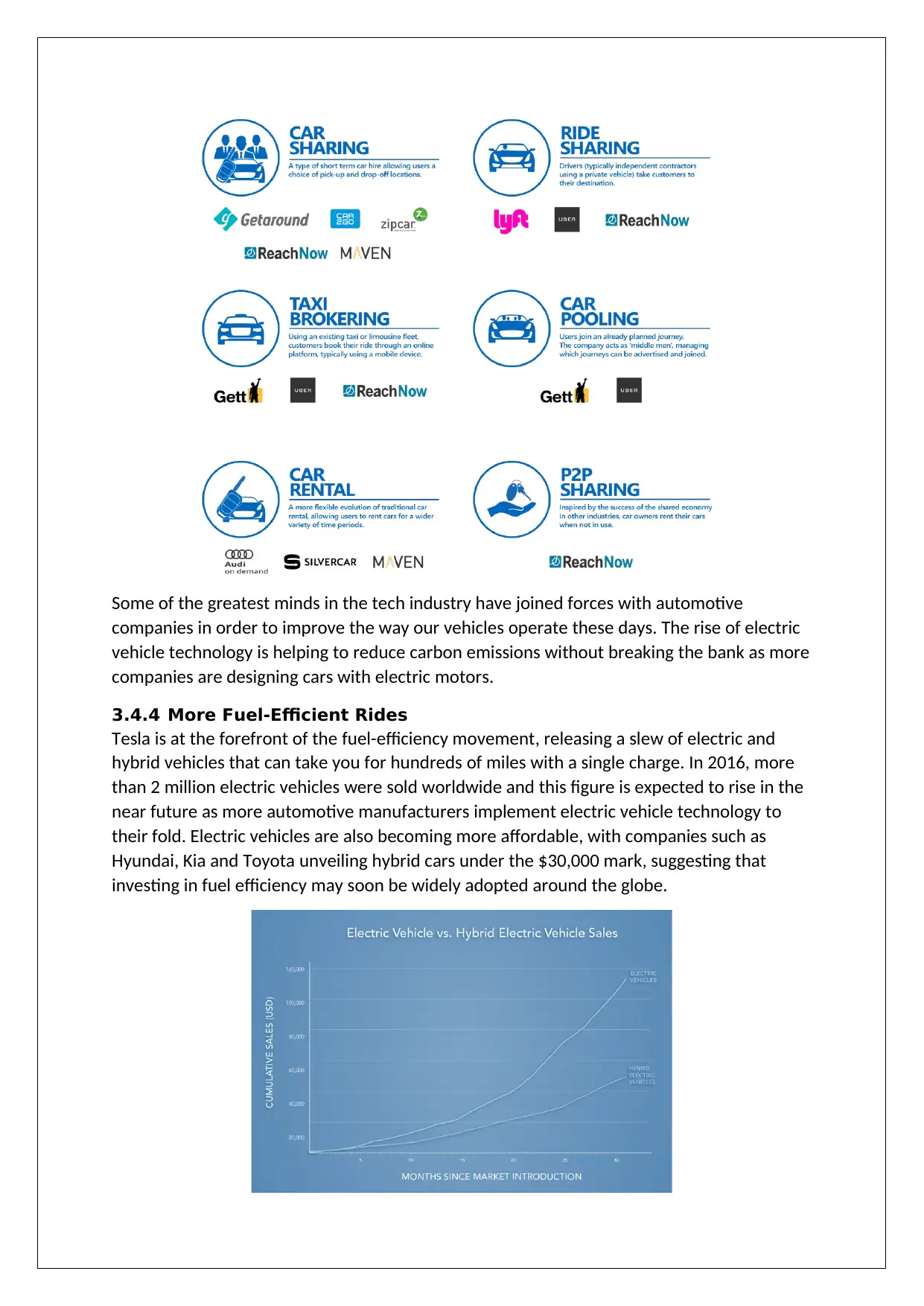
Some of the greatest minds in the tech industry have joined forces with automotive
companies in order to improve the way our vehicles operate these days. The rise of electric
vehicle technology is helping to reduce carbon emissions without breaking the bank as more
companies are designing cars with electric motors.
3.4.4 More Fuel-Efficient Rides
Tesla is at the forefront of the fuel-efficiency movement, releasing a slew of electric and
hybrid vehicles that can take you for hundreds of miles with a single charge. In 2016, more
than 2 million electric vehicles were sold worldwide and this figure is expected to rise in the
near future as more automotive manufacturers implement electric vehicle technology to
their fold. Electric vehicles are also becoming more affordable, with companies such as
Hyundai, Kia and Toyota unveiling hybrid cars under the $30,000 mark, suggesting that
investing in fuel efficiency may soon be widely adopted around the globe.
companies in order to improve the way our vehicles operate these days. The rise of electric
vehicle technology is helping to reduce carbon emissions without breaking the bank as more
companies are designing cars with electric motors.
3.4.4 More Fuel-Efficient Rides
Tesla is at the forefront of the fuel-efficiency movement, releasing a slew of electric and
hybrid vehicles that can take you for hundreds of miles with a single charge. In 2016, more
than 2 million electric vehicles were sold worldwide and this figure is expected to rise in the
near future as more automotive manufacturers implement electric vehicle technology to
their fold. Electric vehicles are also becoming more affordable, with companies such as
Hyundai, Kia and Toyota unveiling hybrid cars under the $30,000 mark, suggesting that
investing in fuel efficiency may soon be widely adopted around the globe.
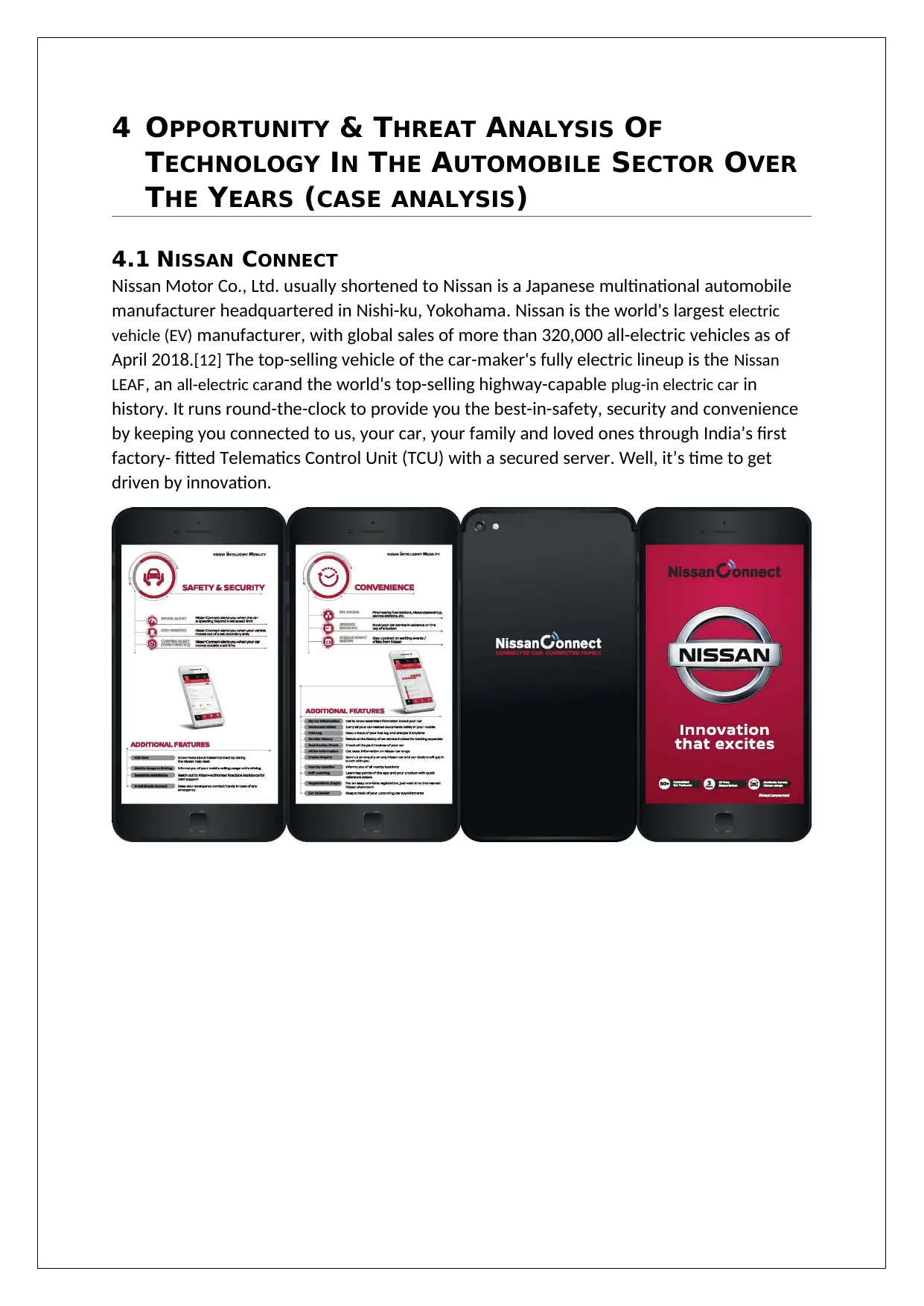
4 OPPORTUNITY & THREAT ANALYSIS OF
TECHNOLOGY IN THE AUTOMOBILE SECTOR OVER
THE YEARS (CASE ANALYSIS)
4.1 NISSAN CONNECT
Nissan Motor Co., Ltd. usually shortened to Nissan is a Japanese multinational automobile
manufacturer headquartered in Nishi-ku, Yokohama. Nissan is the world's largest electric
vehicle (EV) manufacturer, with global sales of more than 320,000 all-electric vehicles as of
April 2018.[12] The top-selling vehicle of the car-maker's fully electric lineup is the Nissan
LEAF, an all-electric carand the world's top-selling highway-capable plug-in electric car in
history. It runs round-the-clock to provide you the best-in-safety, security and convenience
by keeping you connected to us, your car, your family and loved ones through India’s first
factory- fitted Telematics Control Unit (TCU) with a secured server. Well, it’s time to get
driven by innovation.
TECHNOLOGY IN THE AUTOMOBILE SECTOR OVER
THE YEARS (CASE ANALYSIS)
4.1 NISSAN CONNECT
Nissan Motor Co., Ltd. usually shortened to Nissan is a Japanese multinational automobile
manufacturer headquartered in Nishi-ku, Yokohama. Nissan is the world's largest electric
vehicle (EV) manufacturer, with global sales of more than 320,000 all-electric vehicles as of
April 2018.[12] The top-selling vehicle of the car-maker's fully electric lineup is the Nissan
LEAF, an all-electric carand the world's top-selling highway-capable plug-in electric car in
history. It runs round-the-clock to provide you the best-in-safety, security and convenience
by keeping you connected to us, your car, your family and loved ones through India’s first
factory- fitted Telematics Control Unit (TCU) with a secured server. Well, it’s time to get
driven by innovation.
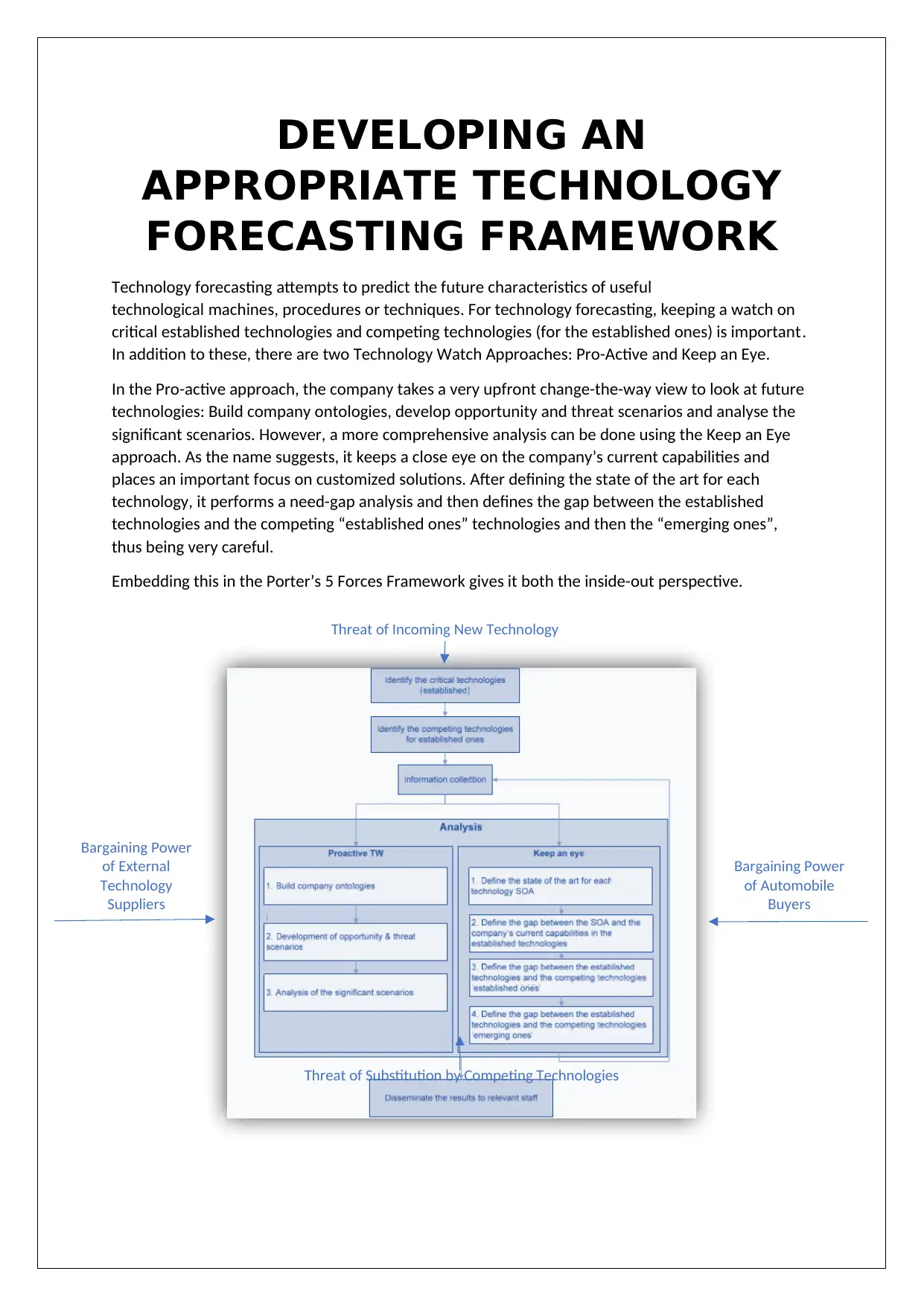
DEVELOPING AN
APPROPRIATE TECHNOLOGY
FORECASTING FRAMEWORK
Technology forecasting attempts to predict the future characteristics of useful
technological machines, procedures or techniques. For technology forecasting, keeping a watch on
critical established technologies and competing technologies (for the established ones) is important.
In addition to these, there are two Technology Watch Approaches: Pro-Active and Keep an Eye.
In the Pro-active approach, the company takes a very upfront change-the-way view to look at future
technologies: Build company ontologies, develop opportunity and threat scenarios and analyse the
significant scenarios. However, a more comprehensive analysis can be done using the Keep an Eye
approach. As the name suggests, it keeps a close eye on the company’s current capabilities and
places an important focus on customized solutions. After defining the state of the art for each
technology, it performs a need-gap analysis and then defines the gap between the established
technologies and the competing “established ones” technologies and then the “emerging ones”,
thus being very careful.
Embedding this in the Porter’s 5 Forces Framework gives it both the inside-out perspective.
Bargaining Power
of External
Technology
Suppliers
Threat of Incoming New Technology
Bargaining Power
of Automobile
Buyers
Threat of Substitution by Competing Technologies
APPROPRIATE TECHNOLOGY
FORECASTING FRAMEWORK
Technology forecasting attempts to predict the future characteristics of useful
technological machines, procedures or techniques. For technology forecasting, keeping a watch on
critical established technologies and competing technologies (for the established ones) is important.
In addition to these, there are two Technology Watch Approaches: Pro-Active and Keep an Eye.
In the Pro-active approach, the company takes a very upfront change-the-way view to look at future
technologies: Build company ontologies, develop opportunity and threat scenarios and analyse the
significant scenarios. However, a more comprehensive analysis can be done using the Keep an Eye
approach. As the name suggests, it keeps a close eye on the company’s current capabilities and
places an important focus on customized solutions. After defining the state of the art for each
technology, it performs a need-gap analysis and then defines the gap between the established
technologies and the competing “established ones” technologies and then the “emerging ones”,
thus being very careful.
Embedding this in the Porter’s 5 Forces Framework gives it both the inside-out perspective.
Bargaining Power
of External
Technology
Suppliers
Threat of Incoming New Technology
Bargaining Power
of Automobile
Buyers
Threat of Substitution by Competing Technologies
Secure Best Marks with AI Grader
Need help grading? Try our AI Grader for instant feedback on your assignments.
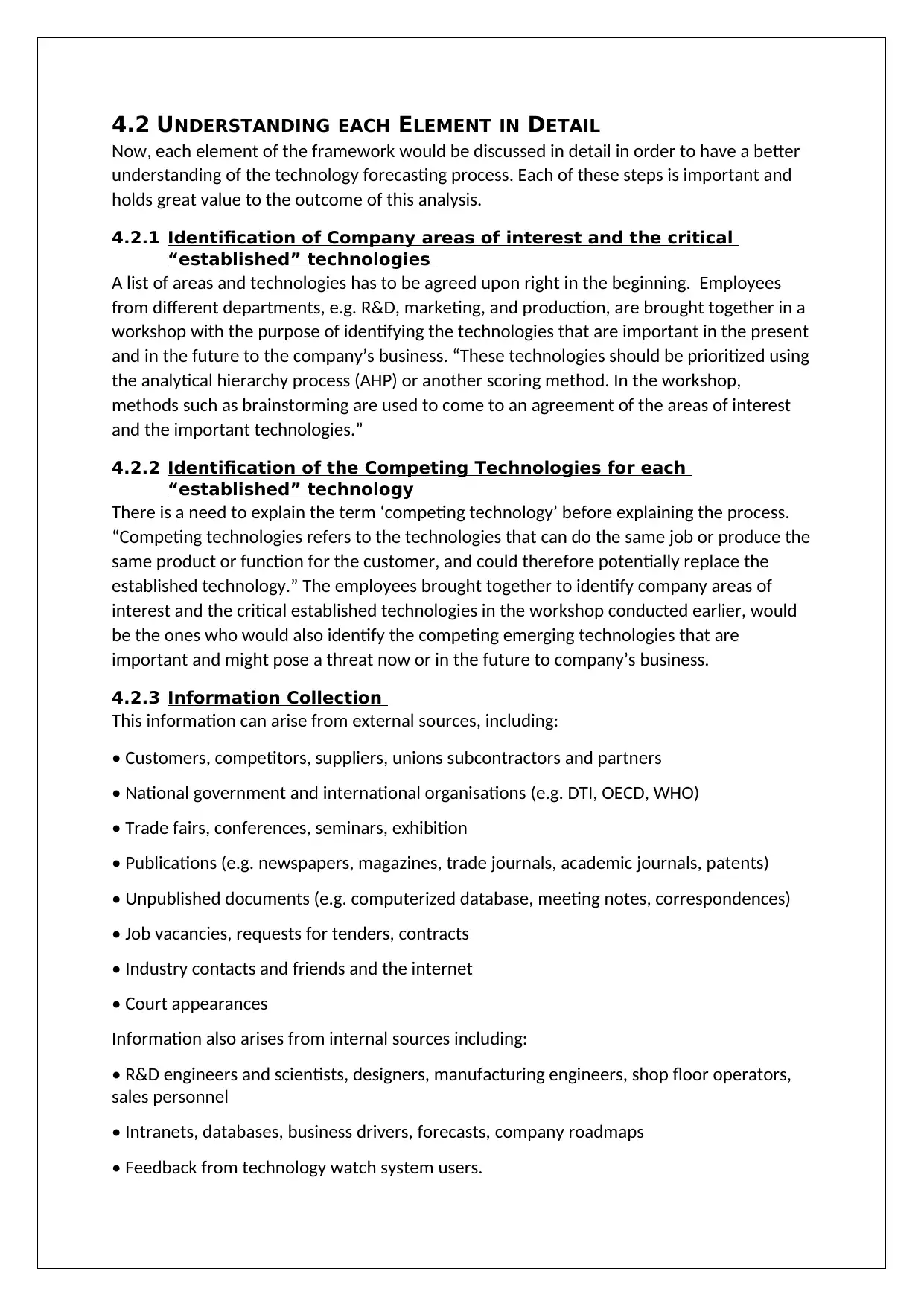
4.2 UNDERSTANDING EACH ELEMENT IN DETAIL
Now, each element of the framework would be discussed in detail in order to have a better
understanding of the technology forecasting process. Each of these steps is important and
holds great value to the outcome of this analysis.
4.2.1 Identification of Company areas of interest and the critical
“established” technologies
A list of areas and technologies has to be agreed upon right in the beginning. Employees
from different departments, e.g. R&D, marketing, and production, are brought together in a
workshop with the purpose of identifying the technologies that are important in the present
and in the future to the company’s business. “These technologies should be prioritized using
the analytical hierarchy process (AHP) or another scoring method. In the workshop,
methods such as brainstorming are used to come to an agreement of the areas of interest
and the important technologies.”
4.2.2 Identification of the Competing Technologies for each
“established” technology
There is a need to explain the term ‘competing technology’ before explaining the process.
“Competing technologies refers to the technologies that can do the same job or produce the
same product or function for the customer, and could therefore potentially replace the
established technology.” The employees brought together to identify company areas of
interest and the critical established technologies in the workshop conducted earlier, would
be the ones who would also identify the competing emerging technologies that are
important and might pose a threat now or in the future to company’s business.
4.2.3 Information Collection
This information can arise from external sources, including:
• Customers, competitors, suppliers, unions subcontractors and partners
• National government and international organisations (e.g. DTI, OECD, WHO)
• Trade fairs, conferences, seminars, exhibition
• Publications (e.g. newspapers, magazines, trade journals, academic journals, patents)
• Unpublished documents (e.g. computerized database, meeting notes, correspondences)
• Job vacancies, requests for tenders, contracts
• Industry contacts and friends and the internet
• Court appearances
Information also arises from internal sources including:
• R&D engineers and scientists, designers, manufacturing engineers, shop floor operators,
sales personnel
• Intranets, databases, business drivers, forecasts, company roadmaps
• Feedback from technology watch system users.
Now, each element of the framework would be discussed in detail in order to have a better
understanding of the technology forecasting process. Each of these steps is important and
holds great value to the outcome of this analysis.
4.2.1 Identification of Company areas of interest and the critical
“established” technologies
A list of areas and technologies has to be agreed upon right in the beginning. Employees
from different departments, e.g. R&D, marketing, and production, are brought together in a
workshop with the purpose of identifying the technologies that are important in the present
and in the future to the company’s business. “These technologies should be prioritized using
the analytical hierarchy process (AHP) or another scoring method. In the workshop,
methods such as brainstorming are used to come to an agreement of the areas of interest
and the important technologies.”
4.2.2 Identification of the Competing Technologies for each
“established” technology
There is a need to explain the term ‘competing technology’ before explaining the process.
“Competing technologies refers to the technologies that can do the same job or produce the
same product or function for the customer, and could therefore potentially replace the
established technology.” The employees brought together to identify company areas of
interest and the critical established technologies in the workshop conducted earlier, would
be the ones who would also identify the competing emerging technologies that are
important and might pose a threat now or in the future to company’s business.
4.2.3 Information Collection
This information can arise from external sources, including:
• Customers, competitors, suppliers, unions subcontractors and partners
• National government and international organisations (e.g. DTI, OECD, WHO)
• Trade fairs, conferences, seminars, exhibition
• Publications (e.g. newspapers, magazines, trade journals, academic journals, patents)
• Unpublished documents (e.g. computerized database, meeting notes, correspondences)
• Job vacancies, requests for tenders, contracts
• Industry contacts and friends and the internet
• Court appearances
Information also arises from internal sources including:
• R&D engineers and scientists, designers, manufacturing engineers, shop floor operators,
sales personnel
• Intranets, databases, business drivers, forecasts, company roadmaps
• Feedback from technology watch system users.
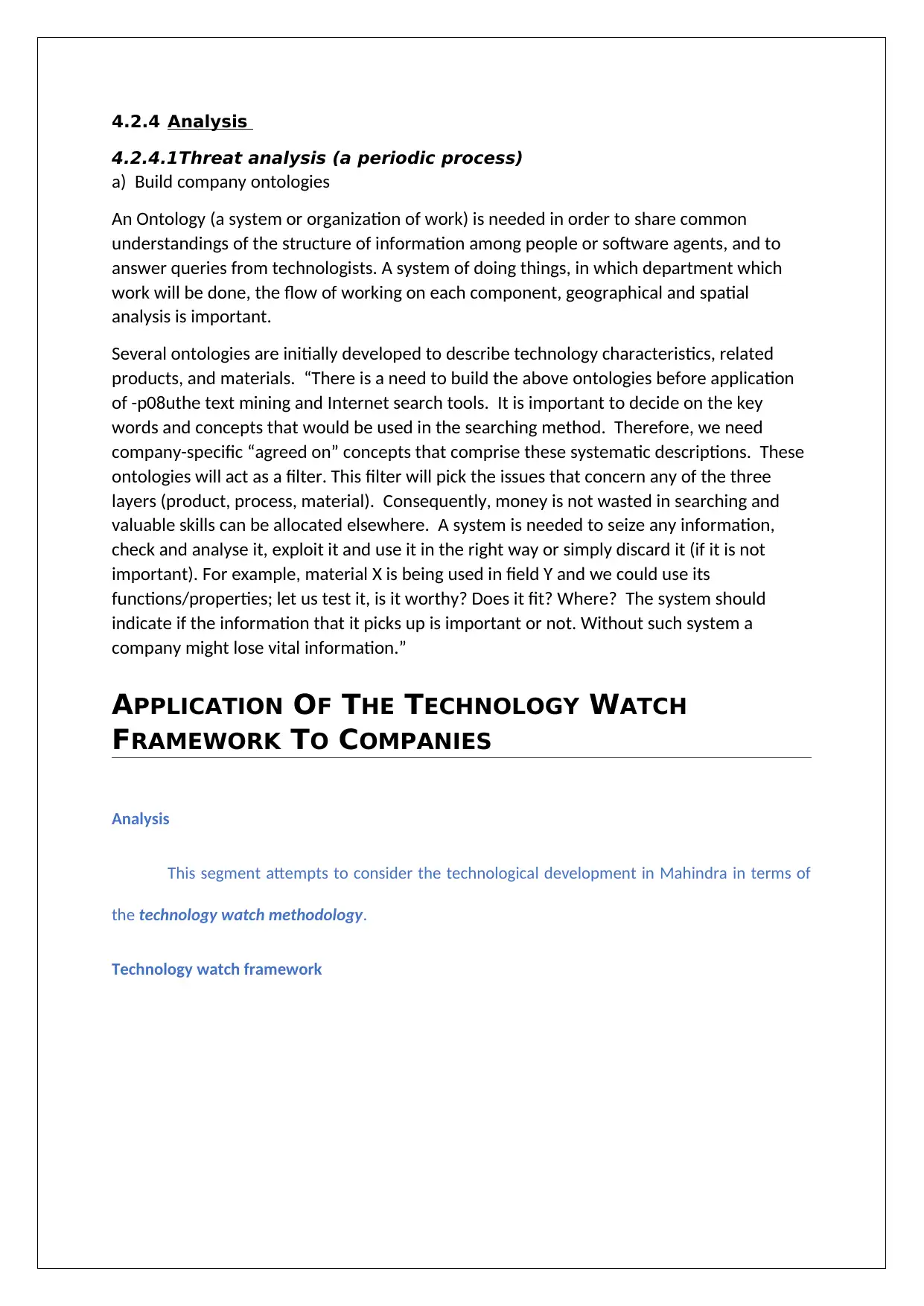
4.2.4 Analysis
4.2.4.1Threat analysis (a periodic process)
a) Build company ontologies
An Ontology (a system or organization of work) is needed in order to share common
understandings of the structure of information among people or software agents, and to
answer queries from technologists. A system of doing things, in which department which
work will be done, the flow of working on each component, geographical and spatial
analysis is important.
Several ontologies are initially developed to describe technology characteristics, related
products, and materials. “There is a need to build the above ontologies before application
of -p08uthe text mining and Internet search tools. It is important to decide on the key
words and concepts that would be used in the searching method. Therefore, we need
company-specific “agreed on” concepts that comprise these systematic descriptions. These
ontologies will act as a filter. This filter will pick the issues that concern any of the three
layers (product, process, material). Consequently, money is not wasted in searching and
valuable skills can be allocated elsewhere. A system is needed to seize any information,
check and analyse it, exploit it and use it in the right way or simply discard it (if it is not
important). For example, material X is being used in field Y and we could use its
functions/properties; let us test it, is it worthy? Does it fit? Where? The system should
indicate if the information that it picks up is important or not. Without such system a
company might lose vital information.”
APPLICATION OF THE TECHNOLOGY WATCH
FRAMEWORK TO COMPANIES
Analysis
This segment attempts to consider the technological development in Mahindra in terms of
the technology watch methodology.
Technology watch framework
4.2.4.1Threat analysis (a periodic process)
a) Build company ontologies
An Ontology (a system or organization of work) is needed in order to share common
understandings of the structure of information among people or software agents, and to
answer queries from technologists. A system of doing things, in which department which
work will be done, the flow of working on each component, geographical and spatial
analysis is important.
Several ontologies are initially developed to describe technology characteristics, related
products, and materials. “There is a need to build the above ontologies before application
of -p08uthe text mining and Internet search tools. It is important to decide on the key
words and concepts that would be used in the searching method. Therefore, we need
company-specific “agreed on” concepts that comprise these systematic descriptions. These
ontologies will act as a filter. This filter will pick the issues that concern any of the three
layers (product, process, material). Consequently, money is not wasted in searching and
valuable skills can be allocated elsewhere. A system is needed to seize any information,
check and analyse it, exploit it and use it in the right way or simply discard it (if it is not
important). For example, material X is being used in field Y and we could use its
functions/properties; let us test it, is it worthy? Does it fit? Where? The system should
indicate if the information that it picks up is important or not. Without such system a
company might lose vital information.”
APPLICATION OF THE TECHNOLOGY WATCH
FRAMEWORK TO COMPANIES
Analysis
This segment attempts to consider the technological development in Mahindra in terms of
the technology watch methodology.
Technology watch framework
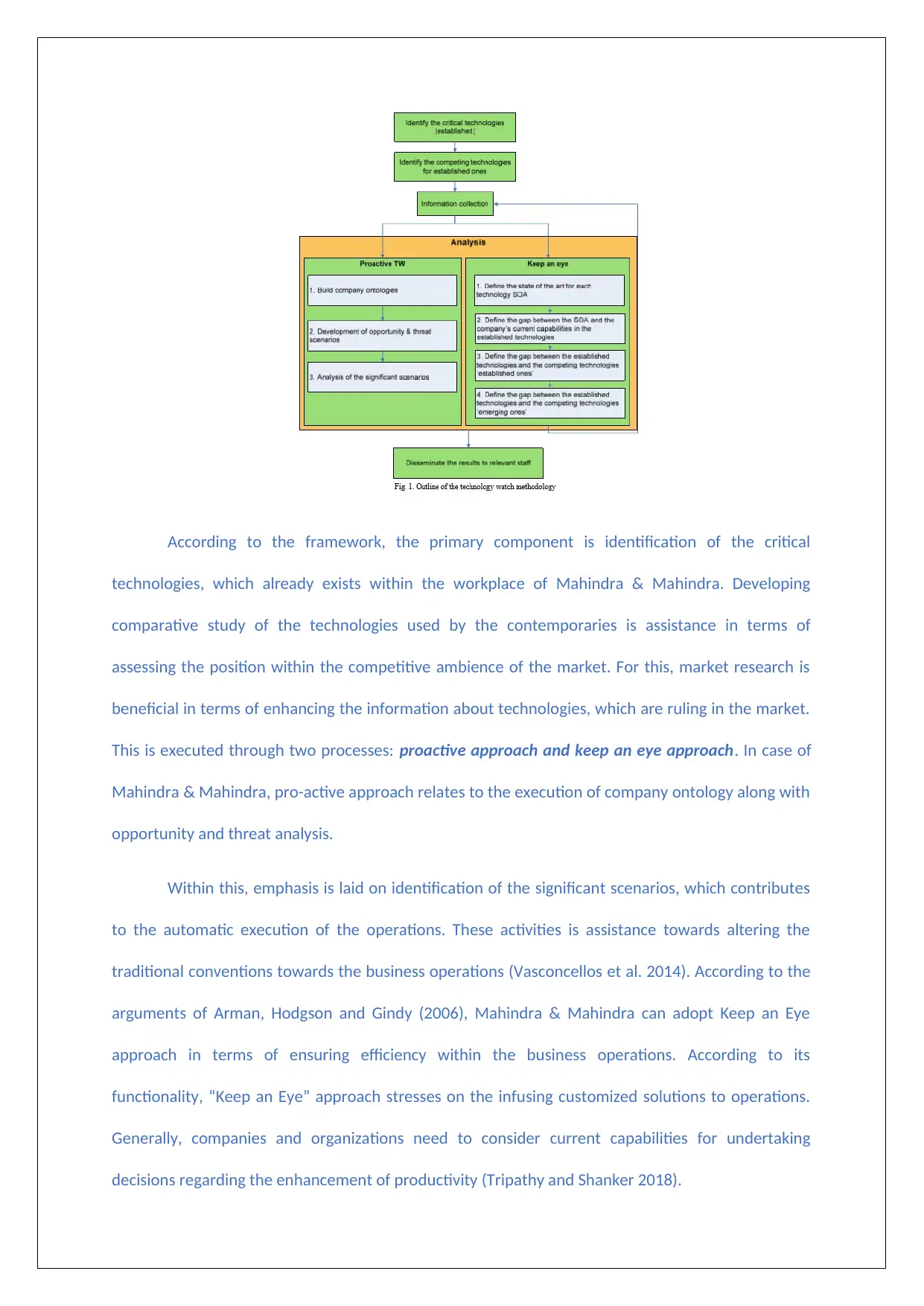
According to the framework, the primary component is identification of the critical
technologies, which already exists within the workplace of Mahindra & Mahindra. Developing
comparative study of the technologies used by the contemporaries is assistance in terms of
assessing the position within the competitive ambience of the market. For this, market research is
beneficial in terms of enhancing the information about technologies, which are ruling in the market.
This is executed through two processes: proactive approach and keep an eye approach. In case of
Mahindra & Mahindra, pro-active approach relates to the execution of company ontology along with
opportunity and threat analysis.
Within this, emphasis is laid on identification of the significant scenarios, which contributes
to the automatic execution of the operations. These activities is assistance towards altering the
traditional conventions towards the business operations (Vasconcellos et al. 2014). According to the
arguments of Arman, Hodgson and Gindy (2006), Mahindra & Mahindra can adopt Keep an Eye
approach in terms of ensuring efficiency within the business operations. According to its
functionality, “Keep an Eye” approach stresses on the infusing customized solutions to operations.
Generally, companies and organizations need to consider current capabilities for undertaking
decisions regarding the enhancement of productivity (Tripathy and Shanker 2018).
technologies, which already exists within the workplace of Mahindra & Mahindra. Developing
comparative study of the technologies used by the contemporaries is assistance in terms of
assessing the position within the competitive ambience of the market. For this, market research is
beneficial in terms of enhancing the information about technologies, which are ruling in the market.
This is executed through two processes: proactive approach and keep an eye approach. In case of
Mahindra & Mahindra, pro-active approach relates to the execution of company ontology along with
opportunity and threat analysis.
Within this, emphasis is laid on identification of the significant scenarios, which contributes
to the automatic execution of the operations. These activities is assistance towards altering the
traditional conventions towards the business operations (Vasconcellos et al. 2014). According to the
arguments of Arman, Hodgson and Gindy (2006), Mahindra & Mahindra can adopt Keep an Eye
approach in terms of ensuring efficiency within the business operations. According to its
functionality, “Keep an Eye” approach stresses on the infusing customized solutions to operations.
Generally, companies and organizations need to consider current capabilities for undertaking
decisions regarding the enhancement of productivity (Tripathy and Shanker 2018).
Paraphrase This Document
Need a fresh take? Get an instant paraphrase of this document with our AI Paraphraser
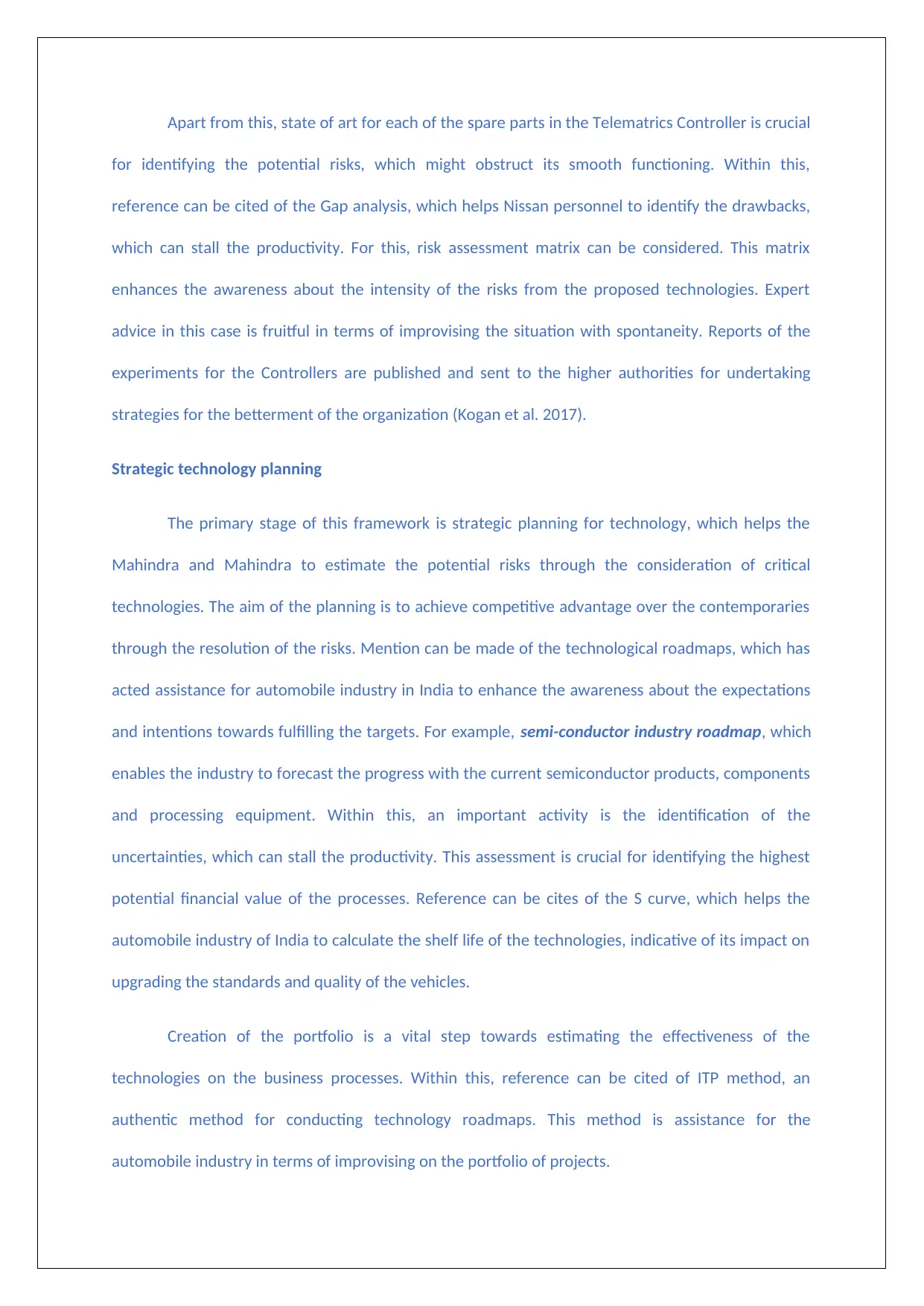
Apart from this, state of art for each of the spare parts in the Telematrics Controller is crucial
for identifying the potential risks, which might obstruct its smooth functioning. Within this,
reference can be cited of the Gap analysis, which helps Nissan personnel to identify the drawbacks,
which can stall the productivity. For this, risk assessment matrix can be considered. This matrix
enhances the awareness about the intensity of the risks from the proposed technologies. Expert
advice in this case is fruitful in terms of improvising the situation with spontaneity. Reports of the
experiments for the Controllers are published and sent to the higher authorities for undertaking
strategies for the betterment of the organization (Kogan et al. 2017).
Strategic technology planning
The primary stage of this framework is strategic planning for technology, which helps the
Mahindra and Mahindra to estimate the potential risks through the consideration of critical
technologies. The aim of the planning is to achieve competitive advantage over the contemporaries
through the resolution of the risks. Mention can be made of the technological roadmaps, which has
acted assistance for automobile industry in India to enhance the awareness about the expectations
and intentions towards fulfilling the targets. For example, semi-conductor industry roadmap, which
enables the industry to forecast the progress with the current semiconductor products, components
and processing equipment. Within this, an important activity is the identification of the
uncertainties, which can stall the productivity. This assessment is crucial for identifying the highest
potential financial value of the processes. Reference can be cites of the S curve, which helps the
automobile industry of India to calculate the shelf life of the technologies, indicative of its impact on
upgrading the standards and quality of the vehicles.
Creation of the portfolio is a vital step towards estimating the effectiveness of the
technologies on the business processes. Within this, reference can be cited of ITP method, an
authentic method for conducting technology roadmaps. This method is assistance for the
automobile industry in terms of improvising on the portfolio of projects.
for identifying the potential risks, which might obstruct its smooth functioning. Within this,
reference can be cited of the Gap analysis, which helps Nissan personnel to identify the drawbacks,
which can stall the productivity. For this, risk assessment matrix can be considered. This matrix
enhances the awareness about the intensity of the risks from the proposed technologies. Expert
advice in this case is fruitful in terms of improvising the situation with spontaneity. Reports of the
experiments for the Controllers are published and sent to the higher authorities for undertaking
strategies for the betterment of the organization (Kogan et al. 2017).
Strategic technology planning
The primary stage of this framework is strategic planning for technology, which helps the
Mahindra and Mahindra to estimate the potential risks through the consideration of critical
technologies. The aim of the planning is to achieve competitive advantage over the contemporaries
through the resolution of the risks. Mention can be made of the technological roadmaps, which has
acted assistance for automobile industry in India to enhance the awareness about the expectations
and intentions towards fulfilling the targets. For example, semi-conductor industry roadmap, which
enables the industry to forecast the progress with the current semiconductor products, components
and processing equipment. Within this, an important activity is the identification of the
uncertainties, which can stall the productivity. This assessment is crucial for identifying the highest
potential financial value of the processes. Reference can be cites of the S curve, which helps the
automobile industry of India to calculate the shelf life of the technologies, indicative of its impact on
upgrading the standards and quality of the vehicles.
Creation of the portfolio is a vital step towards estimating the effectiveness of the
technologies on the business processes. Within this, reference can be cited of ITP method, an
authentic method for conducting technology roadmaps. This method is assistance for the
automobile industry in terms of improvising on the portfolio of projects.

Technology forecasting
Technology forecasting includes four elements:
Time of the forecast/future data when the forecast is to be realized
The technology, which is being forecasted
Functional capabilities of the technology
Probability statement
Prediction of the timing and degree of change are the essential components of the technological
forecasting. Qualitative approaches is a prime evidence for authenticating the estimates. However,
according to the functionalities, Delphi surveys and cross impact matrices are taken into
consideration for the making the estimates. Most of the industries adopt theoretical implementation
of technology forecasting, which sometimes add hypothetical parameter to the management
practices. Probability statements act assistance for the automobile industry of India to develop
concrete and authenticated estimates regarding the probable journey of the technologies in terms
of efficient execution of the business operations.
One of the essential steps in forecasting is to examine the technologies, which would disrupt the
processes and the technologies, which would be crucial in sustaining the resources.
Technology intelligence (TI)
Most of the Mahindra and Mahindra lack systematic communication channels for
disseminating the information. This absence generates disruptions within the various departments
regarding the exposure of collaborative approach. Arbitrary monitoring process reflect the thought
process of the personnel regarding sharing information. In the competitive ambience of the market,
such arbitrary management processes are insufficient for regulating the overall business processes
of automobile industry of India. As per the reports of most of the Mahindra and Mahindra,
incapability to estimate the threats through systems is a common issue. As a result of this issue,
Technology forecasting includes four elements:
Time of the forecast/future data when the forecast is to be realized
The technology, which is being forecasted
Functional capabilities of the technology
Probability statement
Prediction of the timing and degree of change are the essential components of the technological
forecasting. Qualitative approaches is a prime evidence for authenticating the estimates. However,
according to the functionalities, Delphi surveys and cross impact matrices are taken into
consideration for the making the estimates. Most of the industries adopt theoretical implementation
of technology forecasting, which sometimes add hypothetical parameter to the management
practices. Probability statements act assistance for the automobile industry of India to develop
concrete and authenticated estimates regarding the probable journey of the technologies in terms
of efficient execution of the business operations.
One of the essential steps in forecasting is to examine the technologies, which would disrupt the
processes and the technologies, which would be crucial in sustaining the resources.
Technology intelligence (TI)
Most of the Mahindra and Mahindra lack systematic communication channels for
disseminating the information. This absence generates disruptions within the various departments
regarding the exposure of collaborative approach. Arbitrary monitoring process reflect the thought
process of the personnel regarding sharing information. In the competitive ambience of the market,
such arbitrary management processes are insufficient for regulating the overall business processes
of automobile industry of India. As per the reports of most of the Mahindra and Mahindra,
incapability to estimate the threats through systems is a common issue. As a result of this issue,
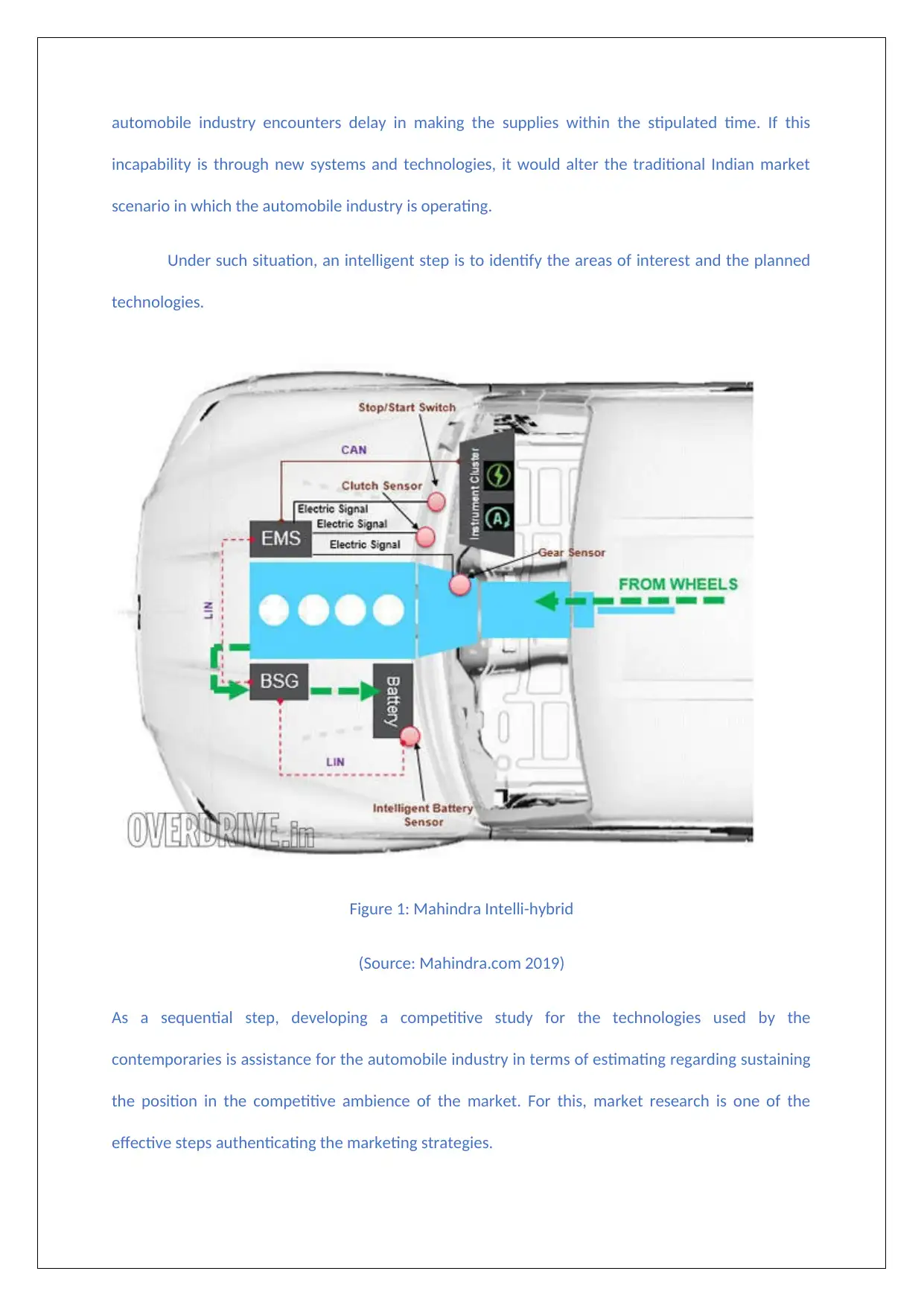
automobile industry encounters delay in making the supplies within the stipulated time. If this
incapability is through new systems and technologies, it would alter the traditional Indian market
scenario in which the automobile industry is operating.
Under such situation, an intelligent step is to identify the areas of interest and the planned
technologies.
Figure 1: Mahindra Intelli-hybrid
(Source: Mahindra.com 2019)
As a sequential step, developing a competitive study for the technologies used by the
contemporaries is assistance for the automobile industry in terms of estimating regarding sustaining
the position in the competitive ambience of the market. For this, market research is one of the
effective steps authenticating the marketing strategies.
incapability is through new systems and technologies, it would alter the traditional Indian market
scenario in which the automobile industry is operating.
Under such situation, an intelligent step is to identify the areas of interest and the planned
technologies.
Figure 1: Mahindra Intelli-hybrid
(Source: Mahindra.com 2019)
As a sequential step, developing a competitive study for the technologies used by the
contemporaries is assistance for the automobile industry in terms of estimating regarding sustaining
the position in the competitive ambience of the market. For this, market research is one of the
effective steps authenticating the marketing strategies.
Secure Best Marks with AI Grader
Need help grading? Try our AI Grader for instant feedback on your assignments.
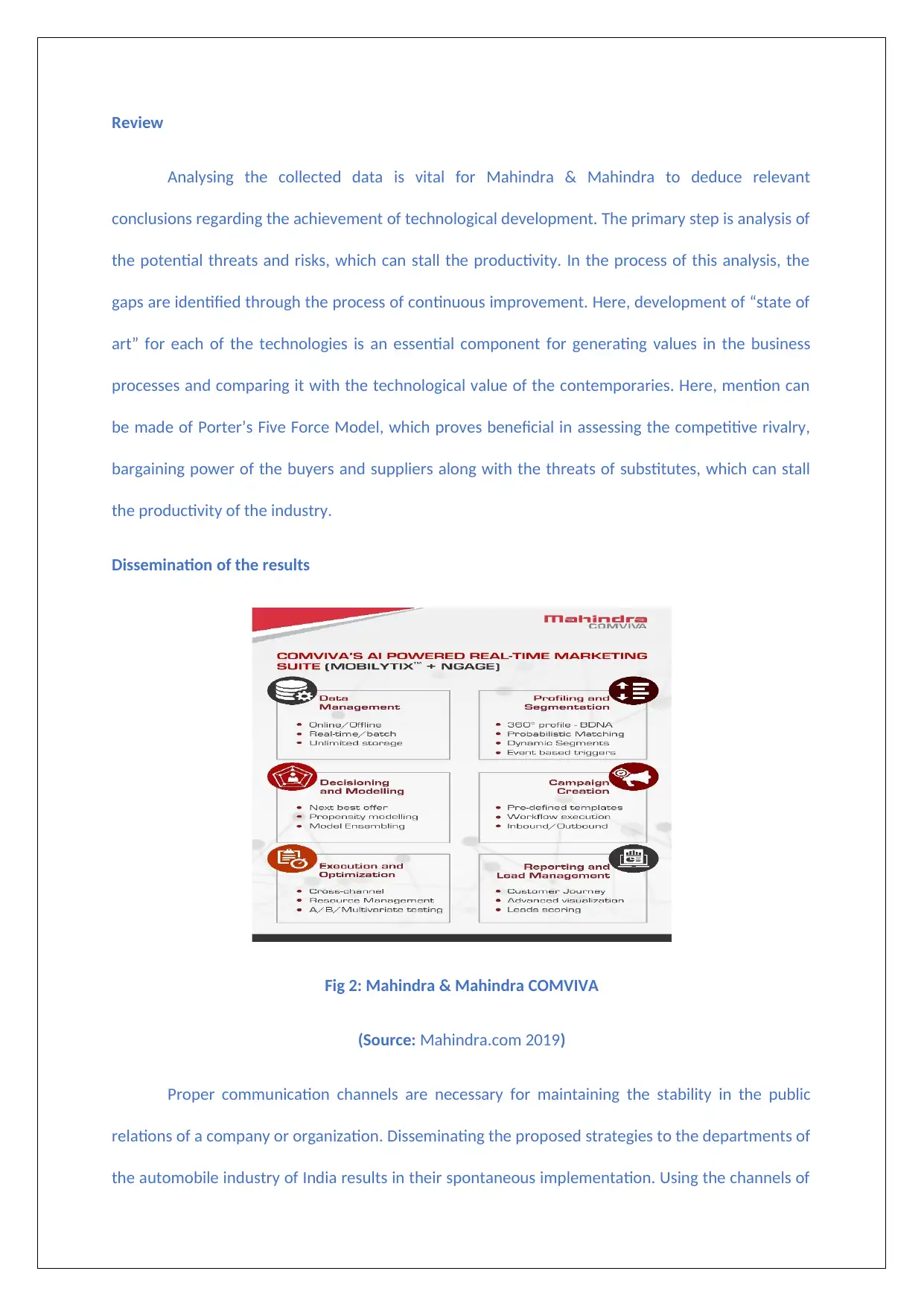
Review
Analysing the collected data is vital for Mahindra & Mahindra to deduce relevant
conclusions regarding the achievement of technological development. The primary step is analysis of
the potential threats and risks, which can stall the productivity. In the process of this analysis, the
gaps are identified through the process of continuous improvement. Here, development of “state of
art” for each of the technologies is an essential component for generating values in the business
processes and comparing it with the technological value of the contemporaries. Here, mention can
be made of Porter’s Five Force Model, which proves beneficial in assessing the competitive rivalry,
bargaining power of the buyers and suppliers along with the threats of substitutes, which can stall
the productivity of the industry.
Dissemination of the results
Fig 2: Mahindra & Mahindra COMVIVA
(Source: Mahindra.com 2019)
Proper communication channels are necessary for maintaining the stability in the public
relations of a company or organization. Disseminating the proposed strategies to the departments of
the automobile industry of India results in their spontaneous implementation. Using the channels of
Analysing the collected data is vital for Mahindra & Mahindra to deduce relevant
conclusions regarding the achievement of technological development. The primary step is analysis of
the potential threats and risks, which can stall the productivity. In the process of this analysis, the
gaps are identified through the process of continuous improvement. Here, development of “state of
art” for each of the technologies is an essential component for generating values in the business
processes and comparing it with the technological value of the contemporaries. Here, mention can
be made of Porter’s Five Force Model, which proves beneficial in assessing the competitive rivalry,
bargaining power of the buyers and suppliers along with the threats of substitutes, which can stall
the productivity of the industry.
Dissemination of the results
Fig 2: Mahindra & Mahindra COMVIVA
(Source: Mahindra.com 2019)
Proper communication channels are necessary for maintaining the stability in the public
relations of a company or organization. Disseminating the proposed strategies to the departments of
the automobile industry of India results in their spontaneous implementation. Using the channels of

Facebook, Twitter, Instagram and other social networking sites is assistance for Mahindra &
Mahindra in terms of reaching to large number of audience at the same time. Uploading the
proposed technologies on these sites is an initiative for increasing the trafficking of the audience
towards the brand image. Along with this, emails are sent to the head of the departments regarding
audits and meetings related to the maintenance of the technologies. Within this, surveys and
feedbacks are crucial for gaining an insight into the approach and opinions of the clients towards the
adopted strategies.
RECOMMENDATIONS
In order to acquire latest and modern technologies, Nissan needs to conduct
comparative study for the technologies, which are ruling in the market. This study
would be effective in terms of selecting the one, which would be feasible for
executing the business operations according to the requirements.
Arranging meetings with the stakeholders and shareholders would be fruitful for
Nissan in terms of preparing reports regarding the developed strategies.
Presentation format of the meetings would be efficient for enhancing the awareness
about the current trends and values generated.
Hiring experts for the examining the machines would be beneficial for Nissan in
terms of averting the malfunctions, virus attacks among others. For this, budget
revisions would act assistance for straining the financial resources.
Mahindra in terms of reaching to large number of audience at the same time. Uploading the
proposed technologies on these sites is an initiative for increasing the trafficking of the audience
towards the brand image. Along with this, emails are sent to the head of the departments regarding
audits and meetings related to the maintenance of the technologies. Within this, surveys and
feedbacks are crucial for gaining an insight into the approach and opinions of the clients towards the
adopted strategies.
RECOMMENDATIONS
In order to acquire latest and modern technologies, Nissan needs to conduct
comparative study for the technologies, which are ruling in the market. This study
would be effective in terms of selecting the one, which would be feasible for
executing the business operations according to the requirements.
Arranging meetings with the stakeholders and shareholders would be fruitful for
Nissan in terms of preparing reports regarding the developed strategies.
Presentation format of the meetings would be efficient for enhancing the awareness
about the current trends and values generated.
Hiring experts for the examining the machines would be beneficial for Nissan in
terms of averting the malfunctions, virus attacks among others. For this, budget
revisions would act assistance for straining the financial resources.

CONCLUSION
All the companies and organizations need to implement effective managerial techniques for
regulating the performance. This is needed especially for the technologies. Management for the
technologies includes forecasting, technology intelligence and gap analysis, which helps automobile
industry of India to make estimates about the future progress with the current assets. In view of the
globalization, the industry needs to conduct market research for gaining an insight into the
technology, which would be feasible for conducting the manufacturing activities properly. Indulging
in joint venture with the research and development team is productive for the industry in terms of
adding innovative touch to the vehicles. Consistency in this approach would be beneficial for luring
the clients and the customers towards the brand image. Evaluation is necessary for upgrading the
standards and quality of the performance.
All the companies and organizations need to implement effective managerial techniques for
regulating the performance. This is needed especially for the technologies. Management for the
technologies includes forecasting, technology intelligence and gap analysis, which helps automobile
industry of India to make estimates about the future progress with the current assets. In view of the
globalization, the industry needs to conduct market research for gaining an insight into the
technology, which would be feasible for conducting the manufacturing activities properly. Indulging
in joint venture with the research and development team is productive for the industry in terms of
adding innovative touch to the vehicles. Consistency in this approach would be beneficial for luring
the clients and the customers towards the brand image. Evaluation is necessary for upgrading the
standards and quality of the performance.
Paraphrase This Document
Need a fresh take? Get an instant paraphrase of this document with our AI Paraphraser
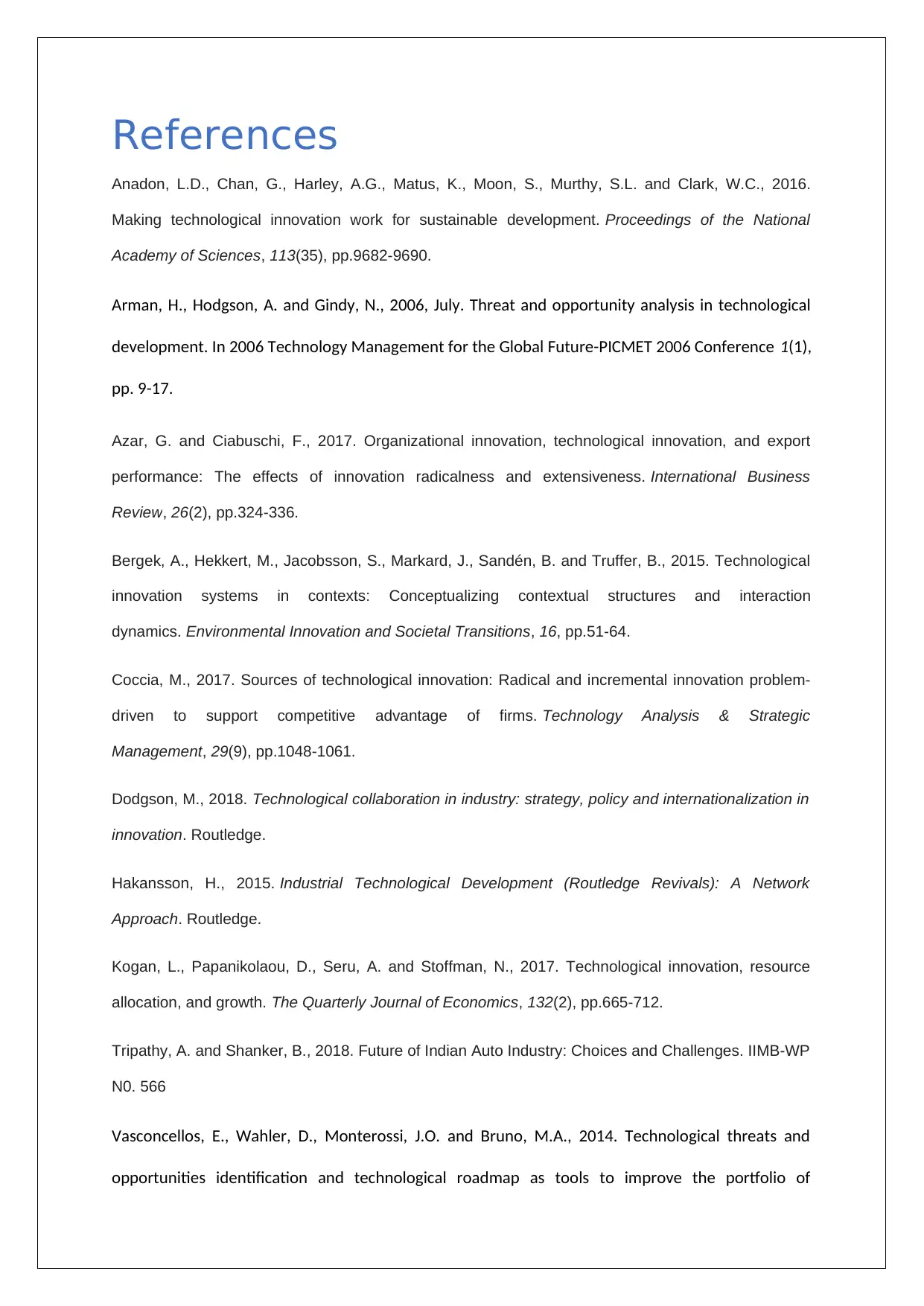
References
Anadon, L.D., Chan, G., Harley, A.G., Matus, K., Moon, S., Murthy, S.L. and Clark, W.C., 2016.
Making technological innovation work for sustainable development. Proceedings of the National
Academy of Sciences, 113(35), pp.9682-9690.
Arman, H., Hodgson, A. and Gindy, N., 2006, July. Threat and opportunity analysis in technological
development. In 2006 Technology Management for the Global Future-PICMET 2006 Conference 1(1),
pp. 9-17.
Azar, G. and Ciabuschi, F., 2017. Organizational innovation, technological innovation, and export
performance: The effects of innovation radicalness and extensiveness. International Business
Review, 26(2), pp.324-336.
Bergek, A., Hekkert, M., Jacobsson, S., Markard, J., Sandén, B. and Truffer, B., 2015. Technological
innovation systems in contexts: Conceptualizing contextual structures and interaction
dynamics. Environmental Innovation and Societal Transitions, 16, pp.51-64.
Coccia, M., 2017. Sources of technological innovation: Radical and incremental innovation problem-
driven to support competitive advantage of firms. Technology Analysis & Strategic
Management, 29(9), pp.1048-1061.
Dodgson, M., 2018. Technological collaboration in industry: strategy, policy and internationalization in
innovation. Routledge.
Hakansson, H., 2015. Industrial Technological Development (Routledge Revivals): A Network
Approach. Routledge.
Kogan, L., Papanikolaou, D., Seru, A. and Stoffman, N., 2017. Technological innovation, resource
allocation, and growth. The Quarterly Journal of Economics, 132(2), pp.665-712.
Tripathy, A. and Shanker, B., 2018. Future of Indian Auto Industry: Choices and Challenges. IIMB-WP
N0. 566
Vasconcellos, E., Wahler, D., Monterossi, J.O. and Bruno, M.A., 2014. Technological threats and
opportunities identification and technological roadmap as tools to improve the portfolio of
Anadon, L.D., Chan, G., Harley, A.G., Matus, K., Moon, S., Murthy, S.L. and Clark, W.C., 2016.
Making technological innovation work for sustainable development. Proceedings of the National
Academy of Sciences, 113(35), pp.9682-9690.
Arman, H., Hodgson, A. and Gindy, N., 2006, July. Threat and opportunity analysis in technological
development. In 2006 Technology Management for the Global Future-PICMET 2006 Conference 1(1),
pp. 9-17.
Azar, G. and Ciabuschi, F., 2017. Organizational innovation, technological innovation, and export
performance: The effects of innovation radicalness and extensiveness. International Business
Review, 26(2), pp.324-336.
Bergek, A., Hekkert, M., Jacobsson, S., Markard, J., Sandén, B. and Truffer, B., 2015. Technological
innovation systems in contexts: Conceptualizing contextual structures and interaction
dynamics. Environmental Innovation and Societal Transitions, 16, pp.51-64.
Coccia, M., 2017. Sources of technological innovation: Radical and incremental innovation problem-
driven to support competitive advantage of firms. Technology Analysis & Strategic
Management, 29(9), pp.1048-1061.
Dodgson, M., 2018. Technological collaboration in industry: strategy, policy and internationalization in
innovation. Routledge.
Hakansson, H., 2015. Industrial Technological Development (Routledge Revivals): A Network
Approach. Routledge.
Kogan, L., Papanikolaou, D., Seru, A. and Stoffman, N., 2017. Technological innovation, resource
allocation, and growth. The Quarterly Journal of Economics, 132(2), pp.665-712.
Tripathy, A. and Shanker, B., 2018. Future of Indian Auto Industry: Choices and Challenges. IIMB-WP
N0. 566
Vasconcellos, E., Wahler, D., Monterossi, J.O. and Bruno, M.A., 2014. Technological threats and
opportunities identification and technological roadmap as tools to improve the portfolio of

technological projects. International Journal of Automotive Technology and Management, 14(1),
pp.25-45.
Mahindra.com 2019. About us. Available at: https://www.mahindra.com/ [Accessed on 27th Feb
2019]
pp.25-45.
Mahindra.com 2019. About us. Available at: https://www.mahindra.com/ [Accessed on 27th Feb
2019]

REFERENCES
1. “Threat and Opportunity Analysis of Technology in Technological Development”
Conference Paper by Husan Arman and Allan Hogdson
2. Interesting Engineering – 20 Greatest Innovations and Inventions of Automobile
Engineering from the first engine to today
3. Ciltinternational- “The Automotive Revolution Autonomous-Connected-Electrified-
Shared”
4. WiRED – “Guide to Self-Driving Cars”
5. Infosys – Connected Vehicles Technology (Ecosystem and Use Cases)
6. Business Insider – Connected Vehicles Report
1. “Threat and Opportunity Analysis of Technology in Technological Development”
Conference Paper by Husan Arman and Allan Hogdson
2. Interesting Engineering – 20 Greatest Innovations and Inventions of Automobile
Engineering from the first engine to today
3. Ciltinternational- “The Automotive Revolution Autonomous-Connected-Electrified-
Shared”
4. WiRED – “Guide to Self-Driving Cars”
5. Infosys – Connected Vehicles Technology (Ecosystem and Use Cases)
6. Business Insider – Connected Vehicles Report
1 out of 34
Related Documents
Your All-in-One AI-Powered Toolkit for Academic Success.
+13062052269
info@desklib.com
Available 24*7 on WhatsApp / Email
![[object Object]](/_next/static/media/star-bottom.7253800d.svg)
Unlock your academic potential
© 2024 | Zucol Services PVT LTD | All rights reserved.





